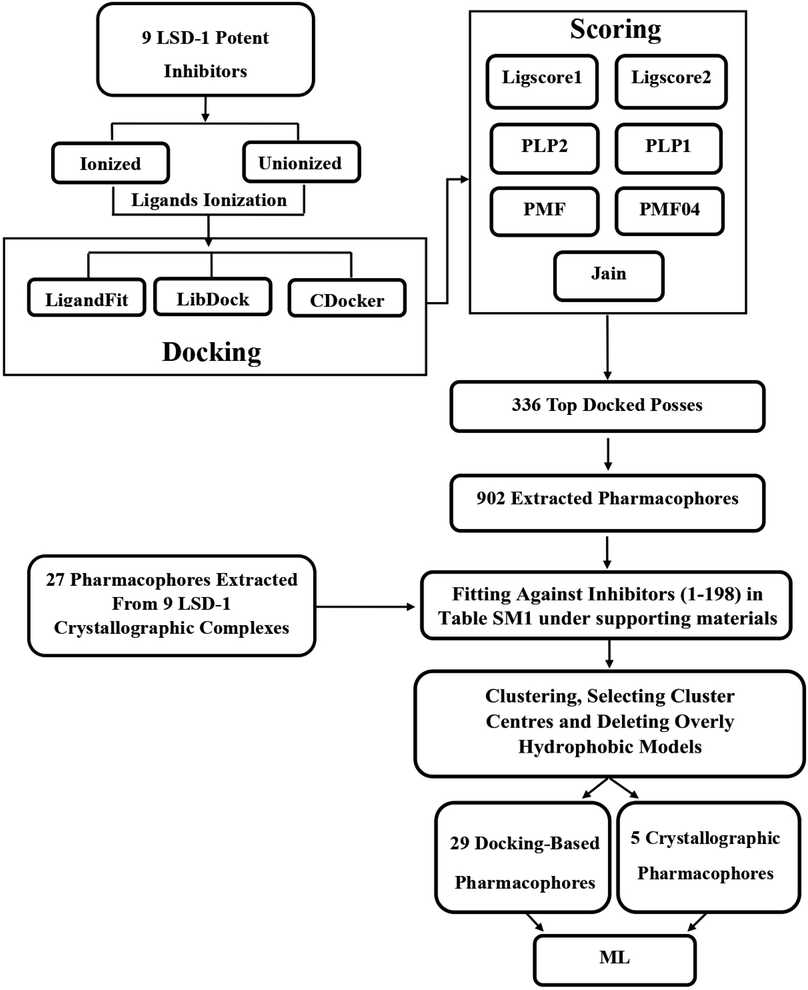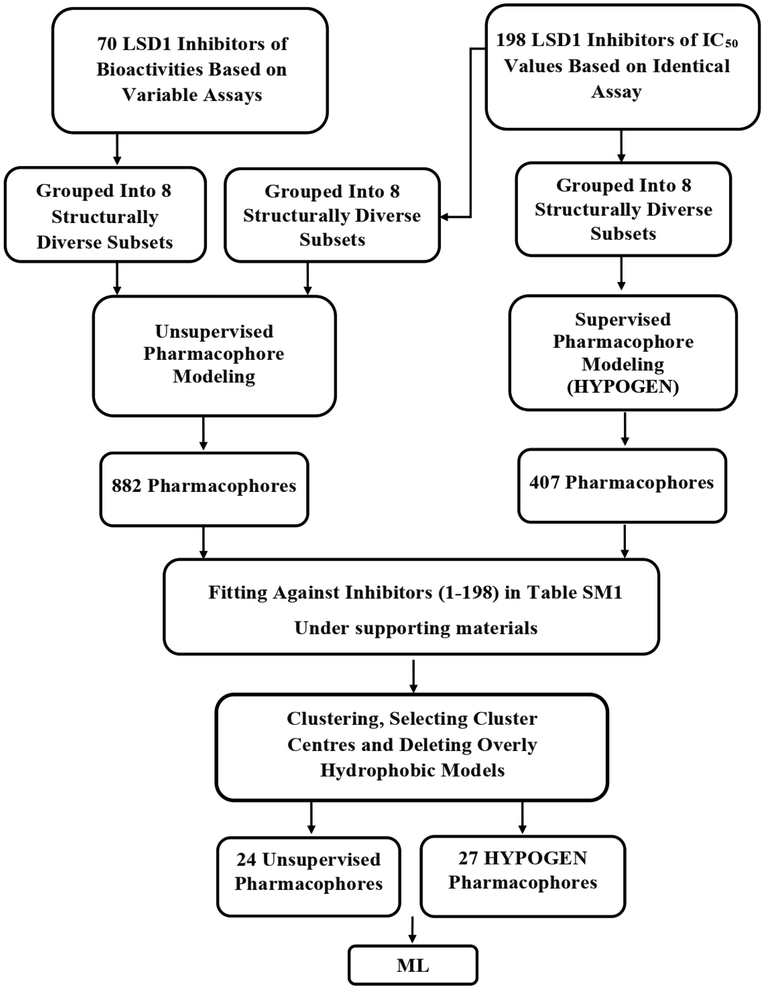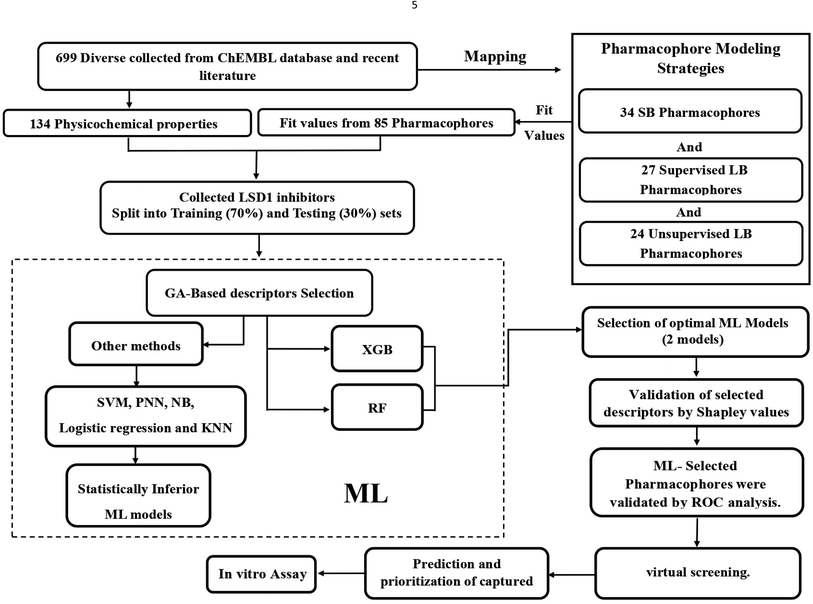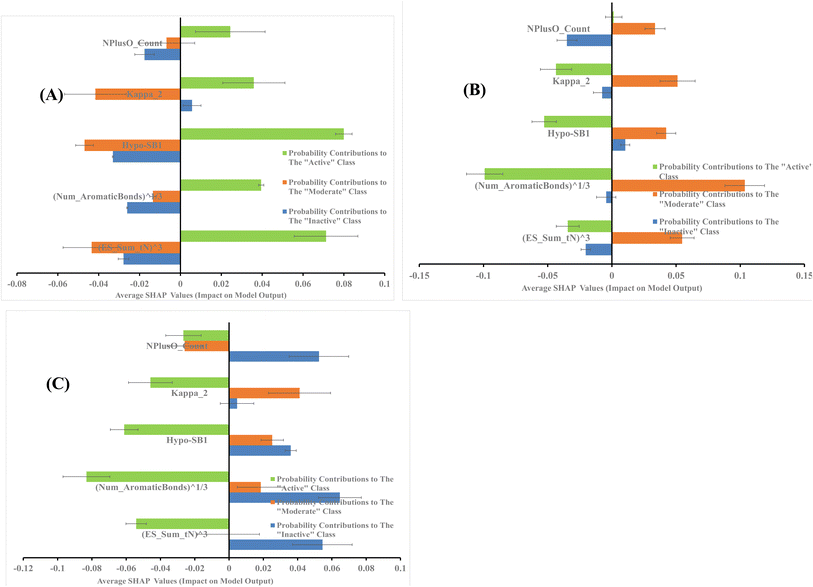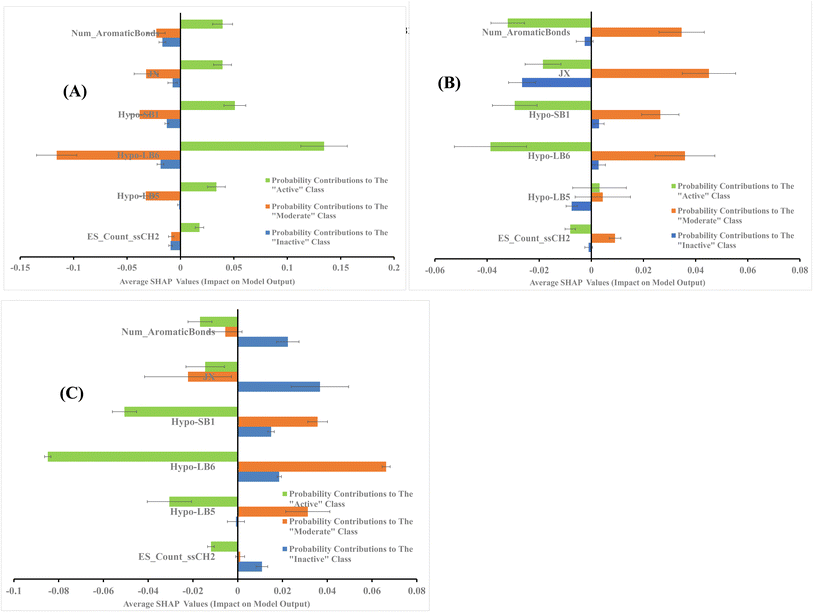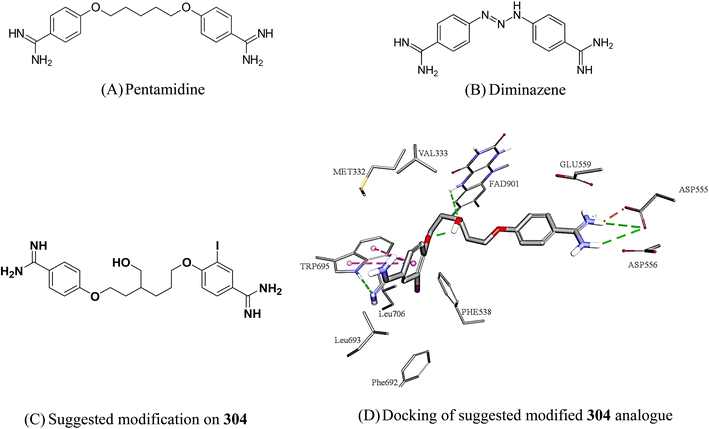 Open Access Article
Open Access ArticleCreative Commons Attribution 3.0 Unported Licence
Discovery of new potent lysine specific histone demythelase-1 inhibitors (LSD-1) using structure based and ligand based molecular modelling and machine learning†
Shada J. Alabeda,
Malek Zihlifb and
Mutasem Taha *c
*c
aDepartment of Pharmacy, Faculty of Pharmacy, Al-Zaytoonah University of Jordan, Amman, Jordan. E-mail: Shada_alabed@yahoo.com
bDepartment of Pharmacology, Faculty of Medicine, University of Jordan, Amman, Jordan. E-mail: m.zihlif@ju.edu.jo
cDepartment of Pharmaceutical Sciences, Faculty of Pharmacy, University of Jordan, Amman, Jordan. E-mail: mutasem@ju.edu.jo
First published on 15th December 2022
Abstract
Lysine-specific histone demethylase 1 (LSD-1) is an epigenetic enzyme that oxidatively cleaves methyl groups from monomethyl and dimethyl Lys4 of histone H3 and is highly overexpressed in different types of cancer. Therefore, it has been widely recognized as a promising therapeutic target for cancer therapy. Towards this end, we employed various Computer Aided Drug Design (CADD) approaches including pharmacophore modelling and machine learning. Pharmacophores generated by structure-based (SB) (either crystallographic-based or docking-based) and ligand-based (LB) (either supervised or unsupervised) modelling methods were allowed to compete within the context of genetic algorithm/machine learning and were assessed by Shapley additive explanation values (SHAP) to end up with three successful pharmacophores that were used to screen the National Cancer Institute (NCI) database. Seventy-five NCI hits were tested for their LSD-1 inhibitory properties against neuroblastoma SH-SY5Y cells, pancreatic carcinoma Panc-1 cells, glioblastoma U-87 MG cells and in vitro enzymatic assay, culminating in 3 nanomolar LSD-1 inhibitors of novel chemotypes.
1. Introduction
“Epigenetics” are inheritable changes in gene expression with no alterations in DNA sequences, which are sufficiently powerful to regulate the dynamics of gene expression.1–3 Covalent modifications of histones can regulate almost all DNA-dependent processes. Recently, it has become more evident that histone modifications, which are controlled by an array of histone modifiers and chromatin-bound proteins, are crucial players in the regulation of transcription activation and repression.4 A balance between specific modifications and modifiers must be maintained at the steady state of the cell to maintain the chromatin structure and proper gene expression program. Once this balance is disrupted, cell phenotypes may be altered to allow disease onset and progression.4Histone methylation involves the attachment of methyl groups to nitrogen atoms in amino acid side chains and/or at the amino termini of various residues.4,5 This process influences gene activity depending on the modified residues, degree and pattern of methylation, and the genomic context of methylation.6,7 Histone methylation was believed to be a stable, inheritable and irreversible process until the identification of FAD (flavin adenine dinucleotide)-dependent nuclear amine oxidase lysine specific demethylase 1 (LSD-1 or KDM1A).8 LSD-1 can demethylate mono- and di-methylated Lys4 or Lys9 on histone H3 under diverse biological settings using FAD as a cofactor and O2 as electron acceptor.9
The pivotal role of LSD-1 in numerous physiological cellular processes, including control of stemness, differentiation, cell motility, epithelial-to-mesenchymal transition and metabolism is well known and studied.10 Nevertheless, a large number of studies have highlighted the association between LSD-1 and cancer. It has been found that LSD-1 is involved in several cancers, including prostate, bladder, lung cancers, neuroblastoma, sarcomas and hepatocarcinomas.11 High expression levels of LSD-1 in cancer cells suggested LSD-1 as a druggable target for cancer treatment. Several LSD-1 inhibitors have been explored, with some of these inhibitors are in clinical trials as potential anti-cancer therapies.12
Computer-Aided Drug Design (CADD) is a widely used approach in the pharmaceutical industry and academia to accelerate development of new drug entities. CADD offers significant reduction in the cost and development time of drug design and discovery research and development.13–15 Recently, Wenchao Lu et al., reviewed the computational approaches employed in drug discovery of new epigenitic inhibitors (epi-drugs), highlighting the importance of CADD in the discovery of new inhibitors in this particular field.16
A variety of CADD techniques were recently explored to identify new LSD-1 modulating compounds and elucidate their binding modes, including molecular dynamic simulation, three-dimensional quantitative structure–activity relationships (3D-QSAR) and pharmacophore modelling.17–20 Despite these efforts, there are still no approved LSD-1 inhibitors in the clinical practice until now.21 The continued interest in LSD-1 prompted us to combine our innovative pharmacophore modelling methods39,40,42,51,55,59–63,65,66,69,73,74,76,96,101,105,106,108,109,112 with machine learning methodologies towards the discovery of new LSD-1 inhibitors. The fundamental novelty of the current project lies in allowing numerous pharmacophore models (of ligand- and structure-based origins) and physicochemical descriptors to compete within genetic algorithm (GA)/machine learning (ML) context for the selection of optimal combination of pharmacophore(s) and physicochemical descriptors within self-consistent and predictive ML model(s). The resulting ML models were judged based on their abilities to explain bioactivity variation within a long list of LSD-1 inhibitors. Optimal ML models and associated pharmacophores were then used to mine the national cancer institute (NCI) list of compounds for novel inhibitory hits and predict their anti-LSD-1 bioactivities. High-ranking hits were bioassayed for their anti-LSD-1 IC50 values. Fig. 1 and 2 show the computational workflows of structure-based (SB) and ligand-based (LB) pharmacophore modelling methods, while Fig. 3 shows the overall ML computational workflow.
2. Material and methods
2.1. Software
The following software packages were utilized in this research:BIOVIA DiscoveryStudio (Version 4.5), Biovia Inc (https://www.3dsbiovia.com/), USA.
KNIME Analytics Platform (Version 4.3.2), https://www.knime.com/.
CS ChemDraw Ultra (Version 11.0), Cambridge Soft Corp. (http://www.cambridgesoft.com/), USA.
GraphPad Prism (Version 8), https://www.graphpad.com/.
Discovery studio was used for docking, ligand-based and structure-based pharmacophore modelling and descriptor calculations. On the other hand, all aspects related to machine learning, including genetic selection of descriptors (including pharmacophores), training and deployment of different learners (i.e., random forests and XgBoost), as well as model evaluation via accuracy, Cohen's kappa and SHAP analysis, were done using graphical programming of KNIME analytics platform.
2.2. Data collection for exploring the pharmacophore space of LSD-1 inhibitors
The European bioinformatics institute database (ChEMBL) (https://www.ebi.ac.uk/chembl/) and recent published literature were searched for known LSD-1 inhibitors. The search identified 714 LSD-1 inhibitors, out of which 43 were reported to have experimental Ki values, and 622 were reported to have experimental IC50 values. The bioactivities of the rest (49 compounds) were reported as LSD-1 inhibition percentage at certain concentrations (ranging from 0.1 to 5 μM). One hundred ninety-eight LSD-1 inhibitors were bio-assayed by an identical assay method and were used for supervised/unsupervised and ligand/structure-based pharmacophore modelling. Eighty-three were reported to be bioassayed employing a multitude of assay methods and thus were only used for unsupervised pharmacophore modelling. ESI Table SM1† shows the collected list of compounds (1–281) of which 1–198 were of consistent bioassays, and 199–281 were discretely bioassayed together with their reported Ki or IC50 values (expressed in μM).18,19,22–362.3. Structure-based pharmacophore modelling
Structure-based pharmacophore modelling depends on interactions within ligand/receptor complexes to extract binding features and arrange them in 3D context (i.e., pharmacophore model(s)).37–39 In addition to crystal structures, which are the main source of structural information,40 virtual complexes obtained by docking potent ligands into corresponding receptors were also employed to extract valid structure-based pharmacophores.40,41In this approach, a small, diverse set of potent molecules are either co-crystallized within the target protein or docked into the binding site of the target. The resulting experimental or virtual ligand–receptor complexes are then used to extract pharmacophore models based on binding interactions perceived from the complexes using the “Ligand-Receptor Pharmacophore Generation” protocol within Discovery Studio. The resulting pharmacophores were allowed herein to compete with other ligand-based pharmacophores within GA/ML context to identify optimal pharmacophore(s) that can best explain bioactivity classifications of a list of LSD-1 inhibitors. Fig. 1 summarizes the computational workflow for structure-based pharmacophore modelling.
2.4. Ligand-based pharmacophore modelling
Ligand-based pharmacophore modelling aims to identify common chemical features among known active compounds irrespective to binding site details.55 The binding features are then assembled in a three-dimensional (3D) binding model, i.e., pharmacophore, to represent a hypothetical binding site. The resulting pharmacophore(s) should not fit inactive compounds or, in a worst case scenario, fits only few inactive compounds.56,57 The most important step to have a successful ligand-based model with an excellent discriminatory predictive power is the selection of reasonable training set(s).58 In this context, ligand-based pharmacophore modelling can either proceed guided by the bioactivities of training compounds (i.e., supervised modelling) or guided by commonalities of binding features among training compounds (i.e., unsupervised modelling).59 In this project, we relied on the HYPOGEN module of Discovery Studio software suite (version 4.5) for supervised pharmacophore modelling.60 Moreover, it was decided to use the “Common Feature Pharmacophore Generation” (also known as HIPHOP) protocol within Discovery Studio for unsupervised ligand-based pharmacophore modelling, i.e., to identify common binding features among potent ligands independent of their bioactivities,59 which allowed us to incorporate additional training compounds irrespective of their bioassay conditions. The computational workflow for ligand-based pharmacophore exploration is summarized in Fig. 2.2.5. Machine learning guided selection of pharmacophores models
![[thin space (1/6-em)]](https://www.rsc.org/images/entities/char_2009.gif) 000 nM or those of percent inhibition <5%, or compounds explicitly labelled as being “inactive” in ChEMBL database, (iii) moderately active of IC50 or Ki ranging from 6000 nM to 125
000 nM or those of percent inhibition <5%, or compounds explicitly labelled as being “inactive” in ChEMBL database, (iii) moderately active of IC50 or Ki ranging from 6000 nM to 125![[thin space (1/6-em)]](https://www.rsc.org/images/entities/char_2009.gif) 000 nM.
000 nM.The refined list (699 compounds) was divided into training and testing sets using the Generate Training and Test Data protocol in Discovery Studio 4.5. This protocol proceeds by clustering collected ML compounds into 20 clusters of maximum dissimilarity between cluster centres calculated based on following properties: logP, molecular weight, number of hydrogen-bond donors (HBDs), number of hydrogen-bond acceptors (HBAs), number of rotatable bonds, number of atoms, number of rings, number of aromatic rings, number of fragments, molecular polar surface, then ca. 30% of each cluster was moved to the testing set. This resulted in a training list that included 492 compounds (≈70% of the refined collected list) out of which 37% are actives, 50% are moderates and 13% are inactives, and a testing set that included 207 compounds (≈30%) out of which 35.7% are actives, 35.3% are moderates and 29% are inactives. ML training and testing sets are deposited in ESI Tables SM10 and SM11,† respectively, in simplified molecular-input line-entry system (SMILES) format.18,19,22–31,33–36
The ML sets (training and testing) were fitted against structure-based and ligand-base pharmacophores (34 from SB modelling, 27 from supervised LB modelling and 24 from unsupervised LB modelling) using the “Best Fit” option and CAESAR conformation–generation algorithm implemented in Discovery Studio (version 4.5). The fit values were calculated by ESI eqn (4) (in Section SM7†) and were used as descriptors in ML. Additionally, 134 physicochemical descriptors were also calculated for training and testing compounds, including numerous topological and fingerprint descriptors using “Calculate Molecular Properties” protocol implemented in Discovery Studio (version 4.5). Moreover, numerous (7947) engineered descriptors were also added by calculating the squares, cubic powers, square roots and cubic roots of different descriptors (physicochemical and pharmacophoric) as well as values resulting from the combinatorial multiplications of fit values of any two pharmacophores against modelled compounds. Overall, ML modelling included 8033 descriptors. The ML workflow is sketched in Fig. 3.
2.5.2.1 Genetic function algorithm-based ML modelling (GA-ML). A gene-based encoding system is implemented herein, whereby the presence or absence of a certain descriptor(s) in a suggested model is encoded by chromosome format. That is, each potential ML model is represented as vector (chromosome) composed of string of bins (genes), whereby each bin (gene) represents a particular independent variable (descriptor), such that if a particular bin is filled with “0” then the corresponding descriptor is absent from the corresponding model under evaluation, while if the bin is filled with “1” then the corresponding descriptor is present in the model. Each chromosome (ML model) is associated with a fitness value that reflects how good it is compared to other solutions. High-ranking chromosomes are allowed to “mate”, i.e., to exchange some of their genes, and their “offspring” are evaluated via their fitness values. Two important GA control parameters need to be configured prior to modelling, namely, the population of initial random chromosomes and the maximum number of generations to exit from a basic cycle and to complete the algorithm.83 In the current project, these were configured as follows: population size = 500 and a maximum number of generations = 10
![[thin space (1/6-em)]](https://www.rsc.org/images/entities/char_2009.gif) 000. We implemented GA node within KNIME Analytics Platform (Version 4.3.2).
000. We implemented GA node within KNIME Analytics Platform (Version 4.3.2).
2.5.2.2 Random forest (RF). RF is a multipurpose ML strategy for classification.77,78 RF is based on the ensemble of decision trees (DTs). Each tree predicts a classification independently and “votes” for the related class. Most of the votes decide the overall RF predictions.84 GA selected descriptors were used to build corresponding RF models. The fitness criterion for the associated GA models was set to the accuracy of the out-of-bag internal validation, which measures prediction error of RF models utilizing subsampling with replacement to create training and testing samples for the model.115,116 The RF learner node within KNIME Analytics Platform (Version 4.3.2) was implemented with the following parameters: Tree options: no minimum node size or maximum tree depth were specified, Split method: GINI, Number of trees = 100.
2.5.2.3 Extreme gradient boosting (XGB). Extreme Gradient Boosting (XGBoost, or XGB) relies on the ensemble of weak DT-type models to create boosted, DT-type models. This system includes a novel tree learning algorithm, a theoretically justified weighted quantile sketch procedure with parallel and distributed computing.79–82 GA selected descriptors were used to build corresponding XGB models. The fitness criterion for the associated GA models was set to the accuracy of the leave-20%-out internal crossvalidation. The XGB Learner node within KNIME Analytics Platform (Version 4.3.2) was implemented with the following parameters: tree booster was implemented with depth wise grow policy, boosting rounds = 100, eta = 0.3, gamma = 0, maximum depth = 6, minimum child weight = 1, maximum delta step = 0, subsampling rate = 1, column sampling rate by tree = 1, column sampling rate by level = 1, lambda = 1, alpha = 1, sketch epsilon = 0.03, scaled positive weight = 1. Maximum number of bins = 256.
2.5.3.1 Accuracy. The accuracies of optimal ML models against the training and testing sets were calculated based on the following equation.85,86
Where N is the number of all compounds in the testing database, TP and TN are the numbers of truly identified “actives” and “inactives”, respectively. Accuracy evaluation against the training set involves removing one (i.e., leave-one-out) or 20% (i.e., leave-20%-out or 5-fold cross-validation) of the data points (i.e., compounds), then building the particular ML model from the remaining data. The model is then used for classifying the removed compounds. The process is repeated until all training data points are removed from the training list and predicted at least once. Accuracy is calculated based on comparing classification results with actual bioactivity classes. Evaluation against the testing set involves calculating the accuracy of the particular ML model by comparing its classification results with the actual bioactivity classes of the testing.88–92
2.5.3.2 Cohen's kappa. The resulting ML models were also validated by Cohen's Kappa depending on the following equation.93,94
where P0 is the relative observed agreement among raters (i.e., accuracy), and Pe is the hypothetical probability of chance agreement. This done by using the observed data to calculate the probabilities of each observer randomly seeing each category. If the raters are in complete agreement, then kappa = 1. If there is no agreement among the raters other than what would be expected by chance (as given by Pe), kappa = 0. Negative Cohen's kappa value implies the agreement is worse than random. Other values are as follows: 0.01–0.20 are considered as none to slight, 0.21–0.40 as fair, 0.41–0.60 as moderate, while 0.61–0.80 as substantial agreement.93,94
2.5.3.3 Shapley values (SHAP). The Shapley value of a particular feature for a certain observation (compound) and prediction indicates how much the feature has contributed to the deviation of the prediction from the base prediction (i.e., the mean prediction over the full sampling data).87,95 The SHAP node was implemented within KNIME Analytics Platform (Version 4.3.2) using K-means to summarize the data to 100 prototypes to start the SHAP node loop. The following parameter was used in SHAP loop: explanation set size (the maximum number of samples SHAP is allowed to use for its estimations) = 100.
ML selected pharmacophores were carefully validated as described earlier39,86,96,97 (e.g., by ROC analysis). Detailed description of the validation is in ESI Section SM11.†
2.6. In Silico screening for new LSD-1 inhibitors
Pharmacophore hypotheses that emerged in optimal ML models were employed as 3D search queries to screen the NCI list of compounds (includes 268![[thin space (1/6-em)]](https://www.rsc.org/images/entities/char_2009.gif) 667 compounds). Screening was performed employing the “Best Flexible Database Search” protocol implemented within Discovery Studio (version 4.5). To predict the activity class of captured hits, each hit was fitted against pharmacophores within the particular optimal ML model using “best fit” option implemented in Discovery Studio and as calculated by ESI eqn (45) (Section SM4†). Other ML selected descriptors were also calculated for hit molecules. Eventually, fit values and other descriptors were substituted in optimal ML models to predict LSD-1 activity classes of hits. Hits predicted to be within the “Active” category or as combination of “Active” and “Moderate” (76 compounds) were acquired for subsequent in vitro testing.
667 compounds). Screening was performed employing the “Best Flexible Database Search” protocol implemented within Discovery Studio (version 4.5). To predict the activity class of captured hits, each hit was fitted against pharmacophores within the particular optimal ML model using “best fit” option implemented in Discovery Studio and as calculated by ESI eqn (45) (Section SM4†). Other ML selected descriptors were also calculated for hit molecules. Eventually, fit values and other descriptors were substituted in optimal ML models to predict LSD-1 activity classes of hits. Hits predicted to be within the “Active” category or as combination of “Active” and “Moderate” (76 compounds) were acquired for subsequent in vitro testing.
2.7. In vitro experimental studies
As SH-SY5Y cells highly express ATP binding cassette subfamily B member 1 (ABCB1, MDR1, normalized expression, NX: 36.8%),100 cell resistance were reversed using verapamil (10 μM), which was added with each hit, and incubated with cells for 72 hours for subsequent MTT viability assay.101,102 Finally, MTT cell proliferation assay results were analysed using GraphPad Prism 8.0 (GraphPad Software, Inc). The inhibitory IC50 values (concentration at which 50% of tested cells are viable) were calculated from the logarithmic trend lines of the corresponding dose–cytotoxicity graphs. r2 and hill slope were also obtained. Measurements were repeated in triplicates.
 Finally, plot the percent inhibition as a function of the inhibitor concentration to determine the IC50 value (concentration at which there was 50% inhibition).
Finally, plot the percent inhibition as a function of the inhibitor concentration to determine the IC50 value (concentration at which there was 50% inhibition).3. Results and discussion
3.1. LSD-1 pharmacophore model generation
3.1.1.1 Crystallographic complex-based pharmacophore modelling. Nine LSD-1 crystal structures (5 L3E, 5LBQ, 5LGN, 5LHG, 5LGT, 5LGU, 5LHH, 5LHI and 5YJB) retrieved from the Protein Data Bank (PDB) (http://www.rcsb.org/pdb) and used to extract pharmacophore models using the “Receptor-Ligand Pharmacophore Generation” protocol implemented in Discovery Studio (version 4.5). The resulting pharmacophores (27 models) were mapped against bioassay-consistent inhibitors 1–198 (ESI Table SM1†), sixteen pharmacophores failed to map more than 5 compounds from the list and six of the models had less than four diverse features. These models were discarded, leaving five pharmacophores (shown in ESI Fig. SM2†) for subsequent ML.
3.1.1.2 Docking-based pharmacophore modelling. The available co-crystallized LSD-1 ligands are of limited chemical diversity. Furthermore, crystallographic complexes usually show some redundant ligand–protein interactions (as they do not account for variations in bioactivity across bioactive ligands). Additionally, given that hydrogen atoms cannot be seen by X-ray, it is challenging to predict the ionization state of complexed ligands.103–107 These issues prompted us to complement pharmacophore models extracted from crystallographic structures with pharmacophores extracted from virtual complexes generated by docking studies. It is reasonable to assume that high-ranking docking solutions, provided by several docking-scoring algorithms, for a set of diverse potent ligands should include realistic binding modes that resemble actual binding pharmacophore(s). ML can then be used as competition arena to select optimal pharmacophore models capable of explaining bioactivity variation within a modelled list of training compounds. This approach should yield realistic pharmacophore model(s) that might be overlooked in crystallographic complexes.40,108
Nine diverse ligands (199, 206, 208, 224, 230, 248, 256, 270 and 276, see ESI Table SM1†) were selected as representatives of the known potent population of LSD-1 inhibitors. Subsequently, they were docked into the binding pocket of LSD-1 in their ionized and unionized states (to compensate for the fact that ligand ionization state is hard to predict within protein binding site).74,109 Three docking engines and 7 scoring functions were implemented in the docking study to diversify the docking solutions of each ligand. This was done to enhance the probability of ML converging on some realistic binding pharmacophore(s) that can best classify LSD-1 ligands based on bioactivity. The process yielded 336 virtual complexes ([7 ionizable compounds × 2 ionization states × 3 docking engines × 7 scoring functions] + [2 non-ionizable compounds × 3 docking engines × 7 scoring functions] = 336). Subsequent use of the “Receptor-Ligand Pharmacophore generation” protocol of Discovery Studio on the resulting virtual complexes yielded 902 pharmacophores. However, these were reduced to 29 representative pharmacophores by discarding 289 pharmacophores that fail to map more than 5 compounds or with less than 4 diverse features, and subsequent clustering of the remaining pharmacophores to allow only diverse models to proceed to ML. The later step was done because similar pharmacophores cause co-linearity-related noise-to-signal issues and ML errors.110,111
3.1.2.1 Supervised pharmacophore modelling. The pharmacophoric space of LSD-1 inhibitors was extensively explored using supervised ligand-based pharmacophore modelling.63,73,75,112 For this purpose, 8 training subsets were carefully selected from collected LSD-1 inhibitors bioassayed by similar procedures (1–198, ESI Table SM1†). Each training subset was selected in such a way to conform with certain envisaged binding mode. Subsequently, the training subsets were used to build 407 pharmacophore models through 64 bioactivity-supervised pharmacophore generation automatic runs within Discovery Studio. However, these were reduced to 27 unique binding hypotheses by discarding pharmacophores that fail to map more than 5 compounds or exhibit less than 4 diverse features, and by subsequent clustering/selecting best cluster representatives to minimize collinearity among pharmacophore descriptor and improved noise-to-signal ratio in subsequent ML.110,111
3.1.2.2 Unsupervised pharmacophore modelling. To account for binding pharmacophores that could emerge from LSD-1 inhibitors bioassayed by discrete bioassay methods, we opted to explore the pharmacophoric space of such inhibitors using unsupervised pharmacophore modelling. This was performed employing the “Common Feature Pharmacophore Generation” protocol within Discovery Studio.59,108 For this purpose, 16 diverse training subsets were carefully selected from collected LSD-1 inhibitors regardless of their bioassay-procedure (compound 1–281, ESI Table SM1†). Members of each training subset were selected in such a way to conform to certain envisaged binding mode. Subsequently, the training subsets were used to build 882 pharmacophore models through 192 automatic runs. However, these were reduced to 24 by discarding pharmacophores that fail to map more than 5 compounds and those of less than 4 diverse features, and subsequent clustering to minimize collinearity and improved noise-to-signal ratio in subsequent ML.110,111
3.2. ML-guided selection of LSD-1 pharmacophores
The fit values of 85 pharmacophores generated by different modelling techniques (SB modelling (34 pharmacophores), supervised LB (27 pharmacophores) and unsupervised LB (24 pharmacophores)) against modelled compounds (using eqn (4), see ESI Section SM7†) were pooled together with 134 additional physicochemical descriptors calculated for the modelled compounds. The collected pharmacophores were allowed to interact by calculating the combinatorial multiplications of any two pharmacophores (i.e., their fit values against modelled compounds), their squares, cubic powers, square roots and cubic roots. This yielded 7813 additional descriptors. Accordingly, the overall number of descriptors enrolled as independent variables in ML were 8032, while the bioactivity class (i.e., active, moderate or inactive) was enlisted as dependent response variable.The sheer number of available explanatory features (i.e., descriptors) means it is necessary to couple ML with GA to single out critical descriptors that control the bioactivity class within training and testing compounds. Needless to say, ML classifiers fail solely to infer useful information about descriptor(s) of greatest control over response (i.e., bioactivity class).113 Accordingly, 8032 features were allowed to compete within the context of GA tournaments using Cohen's kappa of the resulting models as GA fitness criteria.83 The reason for including Cohen's kappa as success criteria to judge the resulting models is because the training set is imbalanced114 i.e., the training list included 37% actives, 50% moderates and 13% inactives. In contrast, the testing set is better balanced with 35.7% actives, 35.3% moderates and 29% inactives.
Seven ML were coupled with GA and evaluated, namely, Support Vector Machine (SVM), Probabilistic Neural Network (PNN), Naïve Bayes (NB), logistic regression, RF, XGB and kNN. However, only two, namely XGB and RF yielded statistically significant classification results.
Table 1 shows the selected descriptors and statistical results of XGB and RF classifiers. The XGB model was validated by external testing as well as internal cross validation through leave-one-out, leave-20%-out. However, the RF model was validated by internal out-of-bag cross-validation (measures prediction error of RF models utilizing subsampling with replacement to create training and testing subsamples from the training set77,78) and external testing set.115,116 The selected pharmacophores were further validated by receiver operating characteristic (ROC) curve analysis shown in Table 2. Fig. 4–6 show ML-selected pharmacophores, while Table 3 shows the X, Y, Z coordinates of the pharmacophore features of each pharmacophore model.
| ML methoda | Selected model descriptorsb,c | Out-of-bag | Leave-20%-outf | Leave-one-outf | Testing setg | ||||
|---|---|---|---|---|---|---|---|---|---|
| Accuracy | Cohen's kappa | Accuracy | Cohen's kappa | Accuracy | Cohen's kappa | Accuracy | Cohen's kappa | ||
| a XGB: eXtreme gradient boosting, RF: random forests.b Hypo-SB1 (Fig. 4) corresponds to the 8th pharmacophore model (serial number) extracted from the docked pose of ionized 206 (Table SM1) within LSD-1 (PDB code: 5LHI) as generated by LibDock and PMF04 scoring function. Hypo-LB5 (Fig. 5): the 2nd pharmacophore generated from training subset F (Table SM4, under ESI) using settings of run 2 in Table SM5 (under ESI). Hupo-LB6 (Fig. 6): the 4th pharmacophore generated from training subset S (Table SM7, under ESI) using settings of run 1 in (Table SM8, under ESI).c NPlusO_Count: is the total number of oxygen and nitrogen atoms in the molecule, kappa_2: is the kappa shape index that correlated with compound structure elongation, ES_Sum_tN: electrotopological state number of terminal nitrogen atom, Num_AromaticBonds and, ES_Count_ssCH2: electrotopological state counts for sp2 hybridized carbon atoms, JX: one of Balaban indices take account of the covalent radii (JX) of the atoms of the molecule.72d Not applicable.e Not determined.f Training list include 492 compounds.g Testing includes 207 compounds. | |||||||||
| XGB | Hypo-SB1, NPlusO_Count, kappa_2, (ES_Sum_tN)3, (Num_AromaticBonds)0.3 | NAd | NAd | 0.83 | 0.71 | 070 | 0.55 | 0.72 | 0.57 |
| RF | Hypo-SB1, Hypo-LB5, Hypo-LB6, ES_Count_ssCH2, Num_AromaticBonds, JX | 0.81 | 0.69 | NDe | NDe | NDe | NDe | 0.63 | 0.43 |
| Pharmacophoresa | ROC-AUCb (%) | ACCc (%) | SENd (%) | SPCe (%) |
|---|---|---|---|---|
| a pharmacophore models are shown in (Fig. 4–6) and their X, Y, Z coordinates are shown in Table 3.b Area under the receiver operating characteristic curve.c Accuracy.d Sensitivity.e Specificity. | ||||
| Hypo-SB1 | 71 | 59 | 45 | 97 |
| Hypo-LB5 | 65 | 67 | 72 | 55 |
| Hypo-LB6 | 71 | 59 | 42 | 100 |
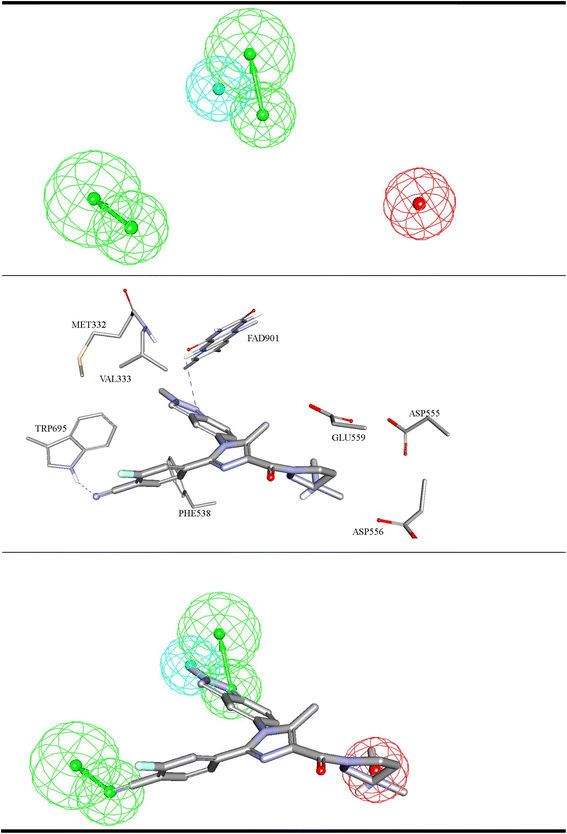 | ||
| Fig. 4 ML-selected structure–based pharmacophore model: Hypo-SB1 (details are as in Table 1). The middle image shows the corresponding virtual docking complexes of 206 (Table SM1†) docked into LSD-1 crystal structure (PDB: 5LHI) (details in Table SM3 under ESI†) from which corresponding pharmacophore was extracted as well as the pharmacophore models fitted against respective docked ligands. PosIon are shown as red spheres, Hbic features as light blue spheres, HBA as green vectored spheres. Hydrogen bonding interactions are shown as blue dashed lines. | ||
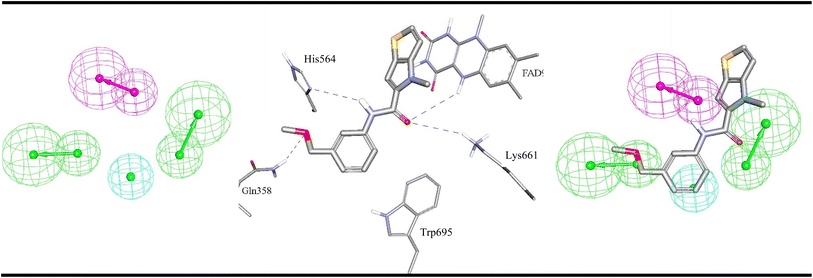 | ||
| Fig. 5 ML-selected ligand–based pharmacophore models generated by supervised modelling (HYPOGEN), Hypo-LB5 (details are as in Table 1). The middle image shows crystallographic complex (PDB codes: 5LGN) showing binding interactions analogous to corresponding pharmacophoric features. Images to the right show the same crystallographic ligands fitted within the corresponding pharmacophore model. Hbic feature is shown as light blue spheres, HBD as purple vectored spheres, HBA as green vectored spheres. Hydrogen bonding interactions are shown as blue dashed lines. | ||
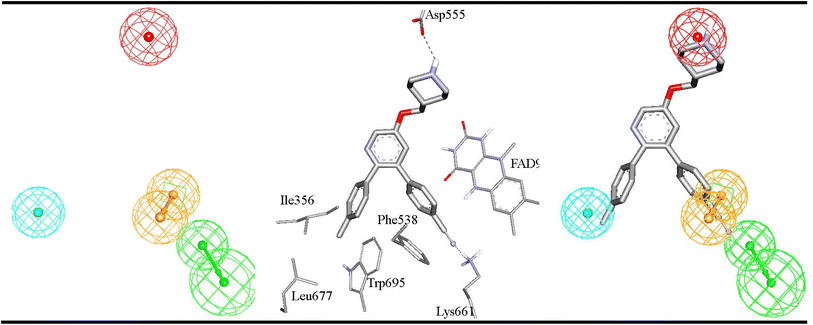 | ||
| Fig. 6 ML-selected ligand–based pharmacophore models generated by unsupervised modelling, Hypo-LB6 (details are as in Table 1). The middle image shows crystallographic complex (PDB code: 5YJB) showing binding interactions analogous to corresponding pharmacophoric features. Image to the right show the same crystallographic ligands fitted within the corresponding pharmacophore model. PosIon are shown as red spheres, Hbic features as light blue spheres, RingArom as brown vectored spheres, HBA as green vectored spheres. Hydrogen bonding interactions are shown as blue dashed lines. | ||
| Model | Definition | Chemical features | ||||||||||||||
|---|---|---|---|---|---|---|---|---|---|---|---|---|---|---|---|---|
| Hypo-SB1 | HBA | HBA | RingArom | PosIon | ||||||||||||
| Tolerances | 1.60 | 2.20 | 1.60 | 2.20 | 1.60 | 2.20 | 1.60 | |||||||||
| Coordinate | X | 9.63 | 10.73 | 6.67 | 8.70 | 7.45 | 6.68 | 1.15 | ||||||||
| Y | −50.07 | −52.29 | −56.23 | −58.13 | −55.38 | −54.30 | −51.03 | |||||||||
| Z | −42.60 | −44.28 | −37.57 | −36.46 | −37.46 | −40.15 | −33.30 | |||||||||
| Hypo-LB5 | HBA | HBA | HBD | Hbic | ||||||||||||
| Weights | 1.76 | 1.76 | 1.76 | 1.76 | ||||||||||||
| Tolerances | 1.60 | 2.20 | 1.60 | 2.20 | 1.60 | 2.20 | 1.60 | |||||||||
| Coordinate | X | 1.74 | 2.79 | −0.63 | 1.54 | 4.29 | 5.94 | −1.00 | ||||||||
| Y | 1.64 | 3.77 | −2.11 | −3.44 | −1.97 | −1.63 | 0.06 | |||||||||
| Z | −4.62 | −6.48 | 0.99 | 2.62 | −0.81 | −3.31 | −2.06 | |||||||||
| Hypo-LB6 | HBA | RingArom | Hbic | PosIon | ||||||||||||
| Weights | 1.00 | 1.00 | 1.00 | 1.00 | ||||||||||||
| Tolerances | 1.70 | 2.30 | 1.70 | 1.70 | 1.70 | 1.70 | ||||||||||
| Coordinate | X | 1.33 | 2.30 | 4.57 | 4.56 | 6.78 | −7.33 | |||||||||
| Y | 3.83 | 5.30 | −1.15 | −1.16 | −2.56 | 0.58 | ||||||||||
| Z | 6.60 | 9.08 | 0.003 | 3.00 | 0.04 | −3.60 | ||||||||||
SHAP values within the context of cheminformatics machine learning enable the identification and prioritization of features that determine compound activity prediction regardless to the ML model.87 The SHAP value of a feature for a certain compound indicates how much the feature has contributed to the deviation of the prediction from the base prediction of that compound (i.e., the mean prediction).
The average SHAP values for GA-selected descriptors in the best GA-XGB and GA-RF models are shown in Fig. 7 and 8. Each value was calculated as the mean of SHAP contributions of the particular descriptor across active, moderate or inactive testing compounds, respectively (the same list used for validating ML models and for ROC analysis of pharmacophores). Clearly from the figures, the selected ML methods (i.e., XGB and RF) are orthogonal as can be seen from their different features and corresponding contributions. Additionally, most GA-selected descriptors exhibited SHAP probability contributions consistent with the bioactivity categories of testing compounds, i.e., they yielded positive probabilities towards the “Active” classification within active testing compounds, while in the same descriptors penalized the probabilities of having moderate or inactive compounds in the same class. Similarly, they showed positive probability contributions towards “Moderate” bioactivity within the moderate testing category, while they penalized the probabilities of having “Active” or “Inactive” compounds within the same category (moderate). A similar trend is seen in “Inactive” category albeit with significant noise resulting from promoting the probabilities of “Moderate” bioactivities within the inactive category. It can be concluded from Fig. 7 and 8 that the most significant and consistent contributors to probability predictions are produced by Hypo-SB1 in both GA-XGB and GA-RF models, while Hypo-LB5 and Hypo-LB6 in GA-RF model.
Fig. 4–6 show how different ML-selected pharmacophores correlate with binding interactions anchoring potent inhibitors within the binding site of LSD-1. Generally, pharmacophores converge on electrostatic attractive interactions linking cationic centers in the ligands with the carboxylates of Asp555, Asp556 or Glu559. Nevertheless, some potent ligands seem to lack such cationic centers. These are successfully represented by Hypo-LB5 that lack this feature (Fig. 5). Additionally, ML-selected pharmacophores seem to encode for hydrogen bonding (HBA or HBD) connecting the ligands with the aromatic system of FAD cofactor, as can be clearly seen in Hypo-SB1 and Hypo-LB5 (Fig. 4 and 5). Still, this interaction is replaced by hydrogen bonding with Lys661 in Hypo-LB6 (Fig. 6). Less significant hydrogen bonding interactions are highlighted by individual pharmacophores including SB pharmacophore Hypo-SB1 which highlight hydrogen bonding with Trp695 as in Fig. 4. Similarly, LB-pharmacophore Hypo-LB5 highlight the interaction with Gln358 and His564 as in Fig. 5.
Moreover, ML-selected pharmacophores appear to converge on hydrophobic/Van der Waals' interactions that anchor ligands into a hydrophobic pouch composed of the side chains of Met332, Val333, Ile356, Phe538, Leu677 and Trp695 (Fig. 4–6).
3.3. In Silico screening for new LSD-1 inhibitors followed by in vitro validation
The fundamental use of pharmacophores and associated ML models is for the discovery of new chemical scaffolds of similar biological profiles (i.e., scaffold hopping). Therefore, it was decided to use Hypo-SB1, Hypo-LB5 and Hypo-LB6 as 3D search queries to screen the NCI list (265![[thin space (1/6-em)]](https://www.rsc.org/images/entities/char_2009.gif) 667 compounds) for new LSD-1 inhibitors. Hypo-SB1 captured 5660 hits, Hypo-LB5 captured 91
667 compounds) for new LSD-1 inhibitors. Hypo-SB1 captured 5660 hits, Hypo-LB5 captured 91![[thin space (1/6-em)]](https://www.rsc.org/images/entities/char_2009.gif) 885 hits while Hypo-LB6 captured 2593 hits. Captured hits were fitted against the three pharmacophores and their fit values together with other relevant calculated descriptors were substituted in ML models in Table 1 to predict their anti-LSD-1 bioactivity classifications. Top ranking hits (76 compounds), i.e., predicted by ML models to be active or moderate, were requested from the NCI and tested in vitro. ESI Fig. SM3† shows the chemical structures of tested hits, while Table 4 shows their NCI codes, predicted and experimental bioactivities against neuroblastoma SH-SY5Y cells (which we selected because they overexpress LSD-1).117,118 From Table 4, it is evident that hits 285, 286, 287, 288, 298, 304, 317 and 325 illustrate significant cytotoxic effects against SH-SY5Y cancer cells. Therefore, their bioactivities were further evaluated at different concentrations. Fig. 9 shows their corresponding dose–response curves. Clearly, they are of reasonable steepness and excellent correlation coefficients. Collectively, these qualities together with the fact that SH-SY5Y cells over-expressed LSD-1 (of normalized expression 42.5%)100 suggest these compounds are potent inhibitors of LSD-1. Some hits required the addition of the P-glycoprotein efflux pump inhibitor, verapamil (10 μM), to reveal their inhibitory profiles against SH-SY5Y cells (their IC50 values marked with asterisks in Table 4).
885 hits while Hypo-LB6 captured 2593 hits. Captured hits were fitted against the three pharmacophores and their fit values together with other relevant calculated descriptors were substituted in ML models in Table 1 to predict their anti-LSD-1 bioactivity classifications. Top ranking hits (76 compounds), i.e., predicted by ML models to be active or moderate, were requested from the NCI and tested in vitro. ESI Fig. SM3† shows the chemical structures of tested hits, while Table 4 shows their NCI codes, predicted and experimental bioactivities against neuroblastoma SH-SY5Y cells (which we selected because they overexpress LSD-1).117,118 From Table 4, it is evident that hits 285, 286, 287, 288, 298, 304, 317 and 325 illustrate significant cytotoxic effects against SH-SY5Y cancer cells. Therefore, their bioactivities were further evaluated at different concentrations. Fig. 9 shows their corresponding dose–response curves. Clearly, they are of reasonable steepness and excellent correlation coefficients. Collectively, these qualities together with the fact that SH-SY5Y cells over-expressed LSD-1 (of normalized expression 42.5%)100 suggest these compounds are potent inhibitors of LSD-1. Some hits required the addition of the P-glycoprotein efflux pump inhibitor, verapamil (10 μM), to reveal their inhibitory profiles against SH-SY5Y cells (their IC50 values marked with asterisks in Table 4).
| Hitsa | NCI code | Captured byb | ML class prediction | Experimental % inhibitionc | In vitro IC50 μMc | |||
|---|---|---|---|---|---|---|---|---|
| Without verapamil | With verapamil | |||||||
| XGB | RF | At 50 μM | At 10 μM | |||||
| a Chemical structures are shown in Fig. SM3.b 1: Hypo-SB1, 2: Hypo-LB5 and 3: Hypo-LB6.c MTT cell viability assay on SH-SY5 cell line.d ND: Not determined.e Positive controls of the experiments.f IC50 values marked with asterisks were determined in presence of verapamil (10 μM). | ||||||||
| 282 | 26![[thin space (1/6-em)]](https://www.rsc.org/images/entities/char_2009.gif) 158 158 |
1, 2 and 3 | Active | Active | 6.16 | 0.06 | NDd | ND |
| 283 | 58![[thin space (1/6-em)]](https://www.rsc.org/images/entities/char_2009.gif) 439 439 |
1 and 2 | Active | Active | 51.22 | 34.30 | ND | ND |
| 284 | 76![[thin space (1/6-em)]](https://www.rsc.org/images/entities/char_2009.gif) 533 533 |
1, 2 and 3 | Active | Active | 52.91 | 49.79 | ND | ND |
| 285 | 84![[thin space (1/6-em)]](https://www.rsc.org/images/entities/char_2009.gif) 456 456 |
1, 2 and 3 | Active | Active | 72.12 | 8.76 | 60.09 | 3.11f |
| 286 | 85![[thin space (1/6-em)]](https://www.rsc.org/images/entities/char_2009.gif) 203 203 |
1, 2 and 3 | Active | Moderate | 63.64 | 0.06 | 49.96 | 7.62f |
| 287 | 106![[thin space (1/6-em)]](https://www.rsc.org/images/entities/char_2009.gif) 717 717 |
1, 2 and 3 | Active | Active | 87.63 | 47.58 | 60.50 | 5.46f |
| 288 | 115![[thin space (1/6-em)]](https://www.rsc.org/images/entities/char_2009.gif) 848 848 |
1 and 2 | Active | Active | 88.50 | 9.46 | 85.41 | 0.24f |
| 289 | 120![[thin space (1/6-em)]](https://www.rsc.org/images/entities/char_2009.gif) 919 919 |
1 and 2 | Active | Active | 12.67 | 6.79 | ND | ND |
| 290 | 123![[thin space (1/6-em)]](https://www.rsc.org/images/entities/char_2009.gif) 463 463 |
2 | Active | Active | 46.79 | 23.46 | ND | ND |
| 291 | 123![[thin space (1/6-em)]](https://www.rsc.org/images/entities/char_2009.gif) 469 469 |
1 and 2 | Active | Moderate | 49.67 | 46.54 | ND | ND |
| 292 | 125![[thin space (1/6-em)]](https://www.rsc.org/images/entities/char_2009.gif) 845 845 |
1 and 2 | Active | Active | 27.42 | 41.38 | ND | ND |
| 293 | 26![[thin space (1/6-em)]](https://www.rsc.org/images/entities/char_2009.gif) 872 872 |
1, 2 and 3 | Active | Active | 26.82 | 0.02 | ND | ND |
| 294 | 127![[thin space (1/6-em)]](https://www.rsc.org/images/entities/char_2009.gif) 751 751 |
1 and 2 | Active | Moderate | 28.17 | 29.46 | ND | ND |
| 295 | 133![[thin space (1/6-em)]](https://www.rsc.org/images/entities/char_2009.gif) 667 667 |
1 and 2 | Active | Active | 47.38 | 37.92 | ND | ND |
| 296 | 135![[thin space (1/6-em)]](https://www.rsc.org/images/entities/char_2009.gif) 759 759 |
1 and 2 | Active | Active | 36.04 | 7.68 | ND | ND |
| 297 | 135![[thin space (1/6-em)]](https://www.rsc.org/images/entities/char_2009.gif) 764 764 |
1 and 2 | Active | Moderate | 30.01 | 14.05 | ND | ND |
| 298 | 146![[thin space (1/6-em)]](https://www.rsc.org/images/entities/char_2009.gif) 496 496 |
1, 2 and 3 | Active | Active | 86.99 | 86.01 | 89.54 | 0.03 |
| 299 | 211![[thin space (1/6-em)]](https://www.rsc.org/images/entities/char_2009.gif) 141 141 |
1, 2 and 3 | Active | Active | 43.36 | 19.02 | ND | ND |
| 300 | 211![[thin space (1/6-em)]](https://www.rsc.org/images/entities/char_2009.gif) 284 284 |
1 and 2 | Active | Moderate | 86.13 | 14.16 | 21.25 | ND |
| 301 | 211![[thin space (1/6-em)]](https://www.rsc.org/images/entities/char_2009.gif) 622 622 |
1, 2 and 3 | Active | Active | 37.58 | 13.37 | ND | ND |
| 302 | 211![[thin space (1/6-em)]](https://www.rsc.org/images/entities/char_2009.gif) 623 623 |
1 and 2 | Active | Active | 24.16 | 22.58 | ND | ND |
| 303 | 211![[thin space (1/6-em)]](https://www.rsc.org/images/entities/char_2009.gif) 632 632 |
1, 2 and 3 | Active | Active | 51.67 | 42.23 | ND | ND |
| 304 | 34![[thin space (1/6-em)]](https://www.rsc.org/images/entities/char_2009.gif) 574 574 |
1 and 2 | Active | Active | 88.87 | 20.96 | 89.31 | 0.37f |
| 305 | 211![[thin space (1/6-em)]](https://www.rsc.org/images/entities/char_2009.gif) 641 641 |
1, 2 and 3 | Active | Active | 55.91 | 34.32 | ND | ND |
| 306 | 212![[thin space (1/6-em)]](https://www.rsc.org/images/entities/char_2009.gif) 212 212 |
1 and 2 | Active | Active | 34.55 | 10.05 | ND | ND |
| 307 | 247![[thin space (1/6-em)]](https://www.rsc.org/images/entities/char_2009.gif) 461 461 |
1, 2 and 3 | Active | Active | 36.37 | 32.73 | ND | ND |
| 308 | 325![[thin space (1/6-em)]](https://www.rsc.org/images/entities/char_2009.gif) 622 622 |
1, 2 and 3 | Active | Moderate | 85.37 | 37.63 | 16.60 | ND |
| 309 | 333![[thin space (1/6-em)]](https://www.rsc.org/images/entities/char_2009.gif) 714 714 |
1 and 2 | Active | Active | 45.58 | 28.47 | ND | ND |
| 310 | 54![[thin space (1/6-em)]](https://www.rsc.org/images/entities/char_2009.gif) 104 104 |
2 | Active | Active | 77.75 | 42.22 | 11.76 | ND |
| 311 | 374![[thin space (1/6-em)]](https://www.rsc.org/images/entities/char_2009.gif) 899 899 |
1, 2 and 3 | Active | Active | 34.55 | 25.71 | ND | ND |
| 312 | 375![[thin space (1/6-em)]](https://www.rsc.org/images/entities/char_2009.gif) 794 794 |
1, 2 and 3 | Active | Active | 27.02 | 33.61 | ND | ND |
| 313 | 681![[thin space (1/6-em)]](https://www.rsc.org/images/entities/char_2009.gif) 721 721 |
1, 2 and 3 | Active | Active | 38.99 | 29.69 | ND | ND |
| 314 | 681![[thin space (1/6-em)]](https://www.rsc.org/images/entities/char_2009.gif) 731 731 |
1 and 2 | Active | Moderate | 81.70 | 45.84 | 32.01 | ND |
| 315 | 45![[thin space (1/6-em)]](https://www.rsc.org/images/entities/char_2009.gif) 525 525 |
2 | Active | Active | 12.34 | 5.58 | ND | ND |
| 316 | 714![[thin space (1/6-em)]](https://www.rsc.org/images/entities/char_2009.gif) 540 540 |
1 and 2 | Active | Moderate | 62.77 | 49.58 | 45.01 | ND |
| 317 | 35![[thin space (1/6-em)]](https://www.rsc.org/images/entities/char_2009.gif) 840 840 |
1, 2 and 3 | Active | Active | 82.71 | 47.42 | 56.74 | 12.21f |
| 318 | 51![[thin space (1/6-em)]](https://www.rsc.org/images/entities/char_2009.gif) 186 186 |
1 and 2 | Active | Moderate | 49.47 | 0 | ND | ND |
| 319 | 55![[thin space (1/6-em)]](https://www.rsc.org/images/entities/char_2009.gif) 149 149 |
1 and 2 | Active | Active | 25.91 | 0 | ND | ND |
| 320 | 55![[thin space (1/6-em)]](https://www.rsc.org/images/entities/char_2009.gif) 230 230 |
1 and 2 | Active | Active | 0 | 0 | ND | ND |
| 321 | 57![[thin space (1/6-em)]](https://www.rsc.org/images/entities/char_2009.gif) 155 155 |
1, 2 and 3 | Active | Active | 52.45 | 5.41 | ND | ND |
| 322 | 18![[thin space (1/6-em)]](https://www.rsc.org/images/entities/char_2009.gif) 351 351 |
3 | Active | Active | 33.04 | 29.78 | ND | ND |
| 323 | 59![[thin space (1/6-em)]](https://www.rsc.org/images/entities/char_2009.gif) 228 228 |
2 | Active | Moderate | 26.6 | 15.79 | ND | NDd |
| 324 | 60![[thin space (1/6-em)]](https://www.rsc.org/images/entities/char_2009.gif) 850 850 |
2 | Active | Active | 14.29 | 6.08 | ND | ND |
| 325 | 64![[thin space (1/6-em)]](https://www.rsc.org/images/entities/char_2009.gif) 983 983 |
3 | Active | Active | 88.81 | 88.85 | 69.57 | 3.17 |
| 326 | 71![[thin space (1/6-em)]](https://www.rsc.org/images/entities/char_2009.gif) 957 957 |
2 | Active | Active | 54.80 | 17.72 | ND | ND |
| 327 | 81![[thin space (1/6-em)]](https://www.rsc.org/images/entities/char_2009.gif) 291 291 |
2 | Active | Active | 44.89 | 4.87 | ND | ND |
| 328 | 95![[thin space (1/6-em)]](https://www.rsc.org/images/entities/char_2009.gif) 623 623 |
1 and 2 | Active | Moderate | 28.62 | 7.40 | ND | ND |
| 329 | 97![[thin space (1/6-em)]](https://www.rsc.org/images/entities/char_2009.gif) 860 860 |
2 | Active | Active | 24.41 | 9.53 | ND | ND |
| 330 | 97![[thin space (1/6-em)]](https://www.rsc.org/images/entities/char_2009.gif) 902 902 |
2 | Active | Active | 16.52 | 12.96 | ND | ND |
| 331 | 101![[thin space (1/6-em)]](https://www.rsc.org/images/entities/char_2009.gif) 100 100 |
2 | Active | Active | 48.65 | 13.25 | ND | ND |
| 332 | 109![[thin space (1/6-em)]](https://www.rsc.org/images/entities/char_2009.gif) 609 609 |
2 | Active | Active | 30.13 | 40.68 | ND | ND |
| 333 | 32![[thin space (1/6-em)]](https://www.rsc.org/images/entities/char_2009.gif) 097 097 |
2 | Active | Active | 70.34 | 33.95 | 0.08 | ND |
| 334 | 113![[thin space (1/6-em)]](https://www.rsc.org/images/entities/char_2009.gif) 226 226 |
2 | Active | Active | 36.55 | 16.48 | ND | ND |
| 335 | 113![[thin space (1/6-em)]](https://www.rsc.org/images/entities/char_2009.gif) 906 906 |
2 | Active | Active | 27.76 | 19.05 | ND | ND |
| 336 | 119![[thin space (1/6-em)]](https://www.rsc.org/images/entities/char_2009.gif) 798 798 |
2 | Active | Active | 61.77 | 34.43 | 27.43 | ND |
| 337 | 121![[thin space (1/6-em)]](https://www.rsc.org/images/entities/char_2009.gif) 360 360 |
2 | Active | Active | 23.21 | 27.77 | ND | ND |
| 338 | 130![[thin space (1/6-em)]](https://www.rsc.org/images/entities/char_2009.gif) 229 229 |
2 | Active | Active | 36.22 | 13.01 | ND | ND |
| 339 | 133![[thin space (1/6-em)]](https://www.rsc.org/images/entities/char_2009.gif) 072 072 |
2 | Active | Active | 13.82 | 12.29 | ND | ND |
| 340 | 157![[thin space (1/6-em)]](https://www.rsc.org/images/entities/char_2009.gif) 395 395 |
2 | Active | Active | 35.32 | 17.36 | ND | ND |
| 341 | 168![[thin space (1/6-em)]](https://www.rsc.org/images/entities/char_2009.gif) 523 523 |
2 | Active | Active | 87.71 | 38.44 | 36.15 | ND |
| 342 | 203![[thin space (1/6-em)]](https://www.rsc.org/images/entities/char_2009.gif) 913 913 |
2 | Active | Active | 72.32 | 12.8 | 27.26 | ND |
| 343 | 213![[thin space (1/6-em)]](https://www.rsc.org/images/entities/char_2009.gif) 775 775 |
2 | Active | Moderate | 32.21 | 16.08 | ND | ND |
| 344 | 32![[thin space (1/6-em)]](https://www.rsc.org/images/entities/char_2009.gif) 453 453 |
2 | Active | Moderate | 79.40 | 47.35 | 40.59 | ND |
| 345 | 216![[thin space (1/6-em)]](https://www.rsc.org/images/entities/char_2009.gif) 807 807 |
2 | Active | Active | 41.36 | 33.83 | ND | ND |
| 346 | 56![[thin space (1/6-em)]](https://www.rsc.org/images/entities/char_2009.gif) 737 737 |
2 | Active | Active | 60.50 | 44.67 | 24.75 | ND |
| 347 | 270![[thin space (1/6-em)]](https://www.rsc.org/images/entities/char_2009.gif) 414 414 |
2 | Active | Active | 13.96 | 0.06 | ND | ND |
| 348 | 370![[thin space (1/6-em)]](https://www.rsc.org/images/entities/char_2009.gif) 162 162 |
2 | Active | Active | 22.73 | 19.96 | ND | ND |
| 349 | 54![[thin space (1/6-em)]](https://www.rsc.org/images/entities/char_2009.gif) 427 427 |
2 | Active | Moderate | 25.69 | 23.30 | ND | ND |
| 350 | 623![[thin space (1/6-em)]](https://www.rsc.org/images/entities/char_2009.gif) 088 088 |
2 | Active | Moderate | 30.47 | 9.16 | ND | ND |
| 351 | 631![[thin space (1/6-em)]](https://www.rsc.org/images/entities/char_2009.gif) 831 831 |
2 | Active | Active | 29.14 | 15.63 | ND | ND |
| 352 | 632![[thin space (1/6-em)]](https://www.rsc.org/images/entities/char_2009.gif) 240 240 |
2 | Active | Active | 17.21 | 6.32 | ND | ND |
| 353 | 635![[thin space (1/6-em)]](https://www.rsc.org/images/entities/char_2009.gif) 116 116 |
2 | Active | Active | 59.36 | 45.86 | ND | ND |
| 354 | 638![[thin space (1/6-em)]](https://www.rsc.org/images/entities/char_2009.gif) 220 220 |
2 | Active | Moderate | 30.33 | 3.24 | ND | ND |
| 355 | 34![[thin space (1/6-em)]](https://www.rsc.org/images/entities/char_2009.gif) 702 702 |
2 | Active | Active | 52.60 | 37.02 | ND | ND |
| 356 | 638![[thin space (1/6-em)]](https://www.rsc.org/images/entities/char_2009.gif) 222 222 |
2 | Active | Moderate | 25.70 | 11.10 | ND | ND |
| 357 | 39![[thin space (1/6-em)]](https://www.rsc.org/images/entities/char_2009.gif) 856 856 |
2 | Active | Active | 7.08 | 0 | ND | ND |
| Tranylcyprominee | 27.83 | 0 | ND | ND | ||||
| Doxorubicine | ND | 91 | ND | 0.60 | ||||
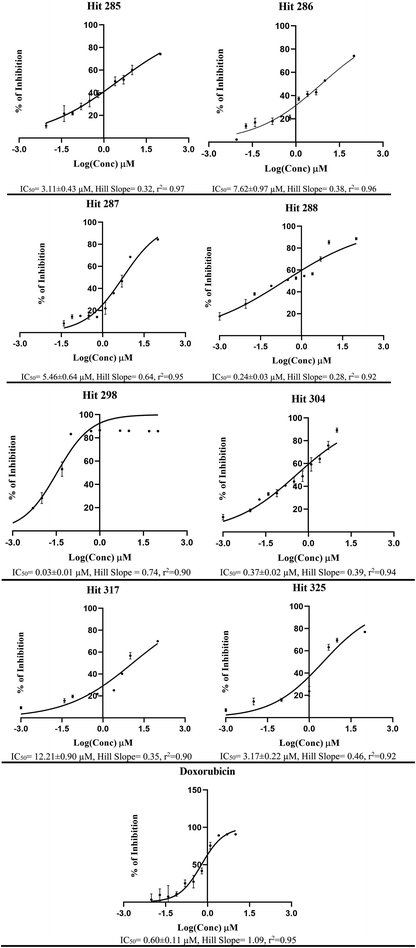 | ||
| Fig. 9 Dose–response curves for most active hits 285, 286, 287, 288, 298, 304, 325, 317 and doxorubicin against neuroblastoma SH-SY5Y cells, corresponding chemical structures are shown in ESI Fig. SM3.† Each point represents triplicate measurements. Compounds 285, 286, 287, 288, 304 and 317 were evaluated in presence of verapamil (10 μM). | ||
It must be mentioned that being amines and amidines, these hits are prone to produce toxic nitrosamines in the gastrointestinal tract due to nitrites and nitrates present in the diet. This reaction is optimal in the stomach at pH 3 to 4.124 Moreover, synthesis of such compounds is complicated by potential impurities related to nitrosamine formation.125
However, to exclude the possibility of targeting other receptors or enzymes, it was decided to (i) directly evaluate their inhibition of LSD-1 enzymatic activity and (ii) evaluate their cytotoxic effects against three more cell lines, namely, pancreatic carcinoma Panc-1 cells (normalized expression of LSD-1 = 29.5%),100 glioblastoma U-87 MG cells (normalized expression of LSD-1 = 12.3%)100 and normal human dermal fibroblasts (HDF). Panc-1 and U-87 MG cells were used to probe LSD-1 inhibition by candidate inhibitors.119,120 However, testing against HDF is aimed at evaluating the selective cytotoxicities of hits.
Bioassay results are shown in Table 5, Fig. 10 and 11. It can be concluded from the table and figures that hits 287, 298 and 304 are nanomolar inhibitors of LSD-1 with reasonable hill slopes121 and consistent cytotoxic effects against tested cancer cell lines, indicating they are authentic LSD-1 inhibitors (i.e., non-promiscuous inhibitors).121 However, 287 showed poor cytotoxic properties against Panc-1 and U-87 MG cells probably because they are generally resistant to cytotoxic compounds.122,123 Interestingly, though, 287 seems to be the least toxic to normal fibroblasts (HDF) with only 7% inhibition at 10 μM, while 298 and 304 showed more pronounced cytotoxicities against HDF suggesting they are involved in extra cytotoxic mechanisms other than LSD-1 inhibition. The structures and purities of the three hits (287, 298 and 304) were confirmed by NMR and mass spectrometry as shown in ESI Fig. SM4–SM8.†
| Cpd | % Inhibition at 10 μM | |||
|---|---|---|---|---|
| LSD-1 enzyme | Panc-1 | U-87 MG | HDF | |
| a r2: regression coefficient of the dose–response curve.b HS: hill Slope.c SI: selectivity index in comparison with SH-SY5Y cells.d Dose/response data is erratic, and it was not possible to construct consistent dose/response curve.e Positive control for the cytotoxicity assays.f Not determined.g Positive control for the enzyme assay experiments. | ||||
| 285 | 18 | 3 | 0 | 31 |
| 286 | 25 | 44 | 33 | 52 (IC50 = 8.33 ± 3.05 μM, r2 = 0.92, HS = 0.42, SI = 1.09) a,b,c |
| 287 | 96 (IC50 = 0.21 ± 0.82 μM, r2 = 0.98, HS = 0.75)a,b | 39 | 15 | 7 |
| 288 | 18 | 41 | 47 | 35 |
| 298 | 78 (IC50 = 0.21 ± 0.56 μM, r2 = 0.93, HS = 0.36) a,b | 93 (IC50 = 0.74 ± 0.09 μM, r2 = 0.95, HS = 0.76, SI = 24.6) a,b,c | 81 (IC50 = 0.92 ± 0.12 μM, r2 = 0.91, HS = 1.09, SI = 30.6) a,b,c | 69 (IC50 = 3.06 ± 0.76 μM, r2 = 0.95, HS = 0.88, SI = 102) a,b,c |
| 304 | 88 (IC50 = 0.61 ± 0.12 μM, r2 = 0.96, HS = 0.70) a,b | 73 (IC50 = 3.85 ± 0.27 μM, r2 = 0.97, HS = 1.00, SI = 2.6) a,b,c | 64 (IC50 = 7.27 ± 0.67 μM, r2 = 0.91, HS = 0.84, SI = 2.5) a,b,c | 68 (IC50 = 5.73 ± 0.29 μM, r2 = 0.83, HS = 2.23, SI = 15.48) a,b,c |
| 317 | 32 | 30 | 32 | 24 |
| 325 | 29 | 93d | 66d | 86 (IC50 = 5.40 ± 0.16 μM, r2 = 0.94, HS = 2.25, SI = 1.7) a,b,c |
| Doxorubicine | NDe | 76 (IC50 = 1.377 ± 0.26 μM, r2 = 0.93, HS = 0.57)a,b | 86 (IC50 = 1.37 ± 0.12 μM, r2 = 0.94, HS = 0.72)a,b | NDf |
| Tranylcypromineg | 40 (IC50 = 20 ± 0.86 μM, r2 = 0.99, HS = 0.61) | NDf | ||
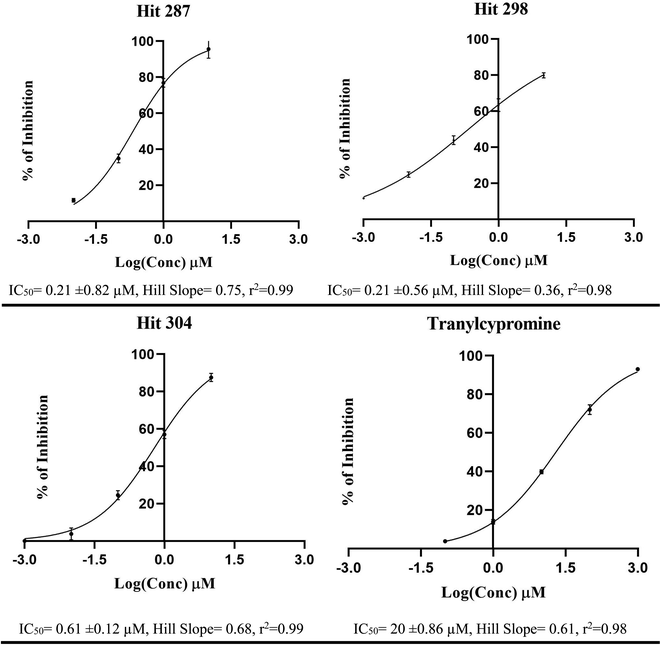 | ||
| Fig. 10 Dose/response curves of prominant compounds 287, 298 and 304 against LSD-1 enzyme. Each point represents duplicate measurements. | ||
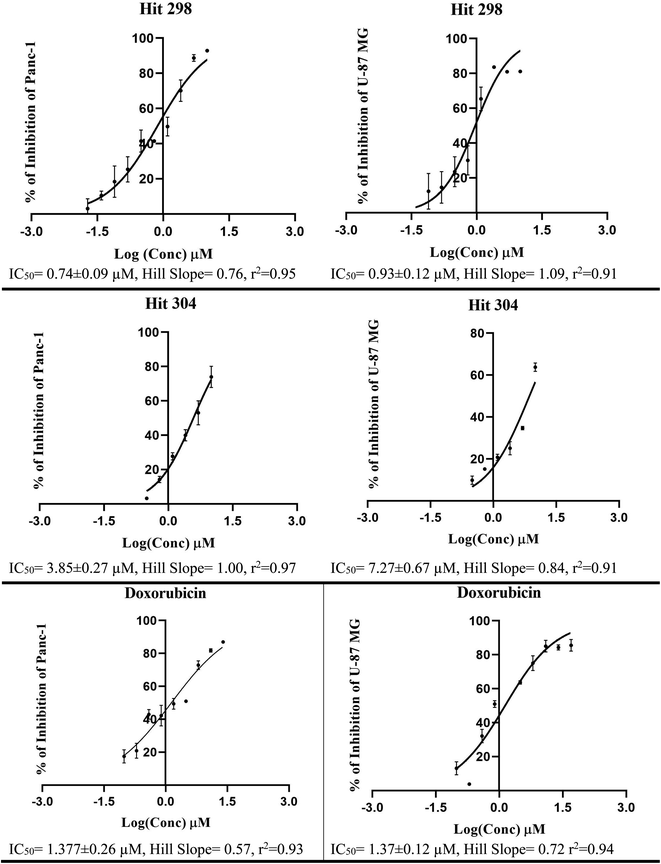 | ||
| Fig. 11 Dose/response curves of prominant compounds 298, 304 and doxorubicin (positive control) against Panc-1 and U-87 MG cancer cell lines. Each point represents triplicate measurements. | ||
Active hits 287, 298 and 304 are shown in Fig. 12. The figure also depicts how the three hits map their respective capturing pharmacophores and how they dock into the binding pocket of LSD-1. Clearly, the ligands interact favourably with some common amino acids such as: electrostatic interaction with Asp555 and Asp556, stacking against the aromatic rings of FAD and Phe538. For example, the carboxylate of Asp556 is situated at 6.8 Å from one of the cationic ammoniums of docked 287, suggesting noticeable mutual electrostatic attraction. Likewise, the cationic ammonium of 298 is docked at an average distance of 7.5 Å from the carboxylates of Asp555, Asp556 and Glu559, which also implies significant electrostatic attraction with these residues. However, one of the two amidines of docked 304 is positioned closest to the same carboxylate side chains, with a separating distance of only 5.1 Å from the COO- of Glu559 suggesting 304 to have the strongest electrostatic attraction to this anionic centre among other active hits.
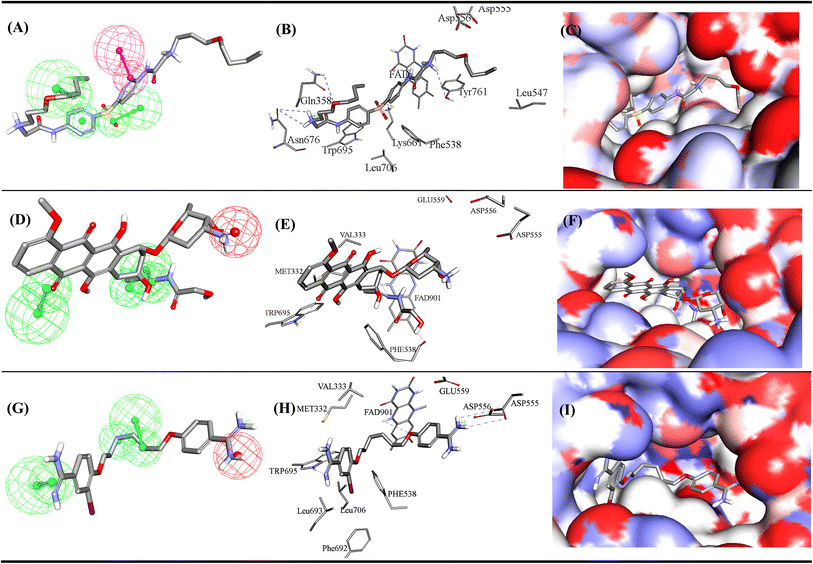 | ||
| Fig. 12 Mapping of most potent hits against corresponding capturing pharmacophores (A) 287 fitted against Hypo-LB5, (B) 287 docked into LSD1 (PDB code: 5LHI), (C) 287 docked into LSD1 with binding site covered with Connolly's surface, (D) 298 fitted against Hypo-SB1, (E) 298 docked into LSD1 (PDB code: 5LHI), (F) 298 docked into LSD1 with binding site covered with Connolly's surface. (G) 304 fitted against Hypo-SB1, (H) 304 docked into LSD1 (PDB code: 5LHI), (I) 304 docked into LSD1 with binding site covered with Connolly's surface. Chemical structures of the compounds are shown in Fig. SM3.† | ||
The three hits seem to share hydrogen bonding interactions with FAD and the Trp695. Nevertheless, each hit seems to exhibit certain unique binding interactions: 287 exhibits extra hydrogen bonding interactions with Gln358, Lys661, Asn676 and Tyr761. While the iodo substituent of 304 fits within a hydrophobic pocket comprised of the hydrophobic side chains of Phe538, Phe692, Leu693 and Leu706. Accordingly, it can be concluded that each hit compound assumes different binding mode within the binding pocket.
Based on similarity to known clinically approved medicinal compounds, we believe 304 to be the best candidate for future optimization towards potent clinically viable LSD1 inhibitors. Hit 304 is closely analogous to the clinically approved antiprotozoal pentamidine (Fig. 13a) and the veterinary antiprotozoal diminazene (Fig. 13b). Moreover, we believe it is possible to significantly enhance its affinity to LSD-1, and therefore reduce its dose and potential toxicity, by reducing the entropic cost of binding through rigidifying its aliphatic linker. We suggest introducing a hydroxyl group to the linker should promote intramolecular hydrogen bonding, as in Fig. 13c, which in turn should rigidify the linker moiety and provides better affinity. Additional related modifications can also be considered in future work.
4. Conclusion
As an epigenetic enzyme that is overexpressed in various malignancies, lysine-specific histone demethylase 1 (LSD-1) is thought to be a prospective therapeutic target for cancer treatment. This encouraged us to model this target via established computational workflows that involve machine learning-guided selection of ligand-based pharmacophore models (either supervised or unsupervised), or machine learning-guided selection of structure-based pharmacophore models (from either co-crystalized ligand or virtual docking of potent LSD-1 inhibitors). The performance of the resulting pharmacophore models was validated and evaluated by ROC curve analysis and SHAP assessment. Three pharmacophore models namely, Hypo-SB1, Hypo-LB5 and Hypo-LB6 were selected and subsequently used as virtual search queries to screen the National Cancer Institute (NCI) database for LSD-1 inhibitors with novel chemotypes. Eight hits: 285, 286, 287, 288, 298, 304, 317 and 385 showed promising LSD-1 inhibition upon testing against neuroblastoma SH-SY5Y cells. Further evaluation against other cancer cell lines (Panc-1 and U-87 MG) and in vitro LSD-1 enzymatic assay indicated nanomolar activities for 287, 298 and 304. The latter is particularly interesting because of its close analogy to the approved antiprotozoals pentamidine and diminazene. Additionally, we believe it can be readily optimized to become even more potent clinically approved LSD1 inhibitor.Conflicts of interest
There are no conflicts of interest to declare.Acknowledgements
The authors thank the Deanship of Academic Research at the University of Jordan for funding this project.References
- Q. W. Chen, X. Y. Zhu, Y. Y. Li and Z. Q. Meng, Oncol. Rep., 2014, 31, 523–532 CrossRef CAS PubMed.
- R. Kanwal and S. Gupta, J. Appl. Physiol., 2010, 109, 598–605 CrossRef CAS PubMed.
- Y. Lu, Y.-T. Chan, H.-Y. Tan, S. Li, N. Wang and Y. Feng, Mol. Cancer, 2020, 19, 1–16 Search PubMed.
- Z. Zhao and A. Shilatifard, Genome Biol., 2019, 20, 1–16 CrossRef CAS PubMed.
- M. Luo, Chem. Rev., 2018, 118, 6656 CrossRef CAS PubMed.
- E. L. Greer and Y. Shi, Nat. Rev. Genet., 2012, 13, 343–357 CrossRef CAS PubMed.
- A. Jambhekar, A. Dhall and Y. Shi, Nat. Rev. Mol. Cell Biol., 2019, 20, 625–641 CrossRef CAS PubMed.
- Y. Shi, F. Lan, C. Matson, P. Mulligan, J. Whetstine, P. Cole, R. Casero and Y. Shi, Cell, 2004, 119, 941–953 CrossRef CAS PubMed.
- X. Fu, P. Zhang and B. Yu, Future Med. Chem., 2017, 9, 1227–1242 CrossRef CAS PubMed.
- B. Majello, F. Gorini, C. Saccà and S. Amente, Cancers (Basel), 2019, 11, 324–439 CrossRef CAS PubMed.
- S. Amente, L. Lania and B. Majello, Biochim. Biophys. Acta, 2013, 1829, 981–986 CrossRef CAS PubMed.
- Y. Fang, G. Liao and B. Yu, J. Hematol. Oncol., 2019, 12, 1–14 CrossRef CAS PubMed.
- P. S. Das and P. Saha, World J. Pharm. Pharm. Sci., 2017, 6, 279–291 CAS.
- T. Talele, S. Khedkar and A. Rigby, Curr. Top. Med. Chem., 2010, 10, 127–141 CrossRef CAS PubMed.
- M. H. Baig, K. Ahmad, G. Rabbani, M. Danishuddin and I. Choi, Curr. Neuropharmacol., 2017, 16, 740–748 CrossRef PubMed.
- W. Lu, R. Zhang, H. Jiang, H. Zhang and C. Luo, Front. Chem., 2018, 6, 57 CrossRef PubMed.
- F. Andreoli and A. Del Rio, Comput. Struct. Biotechnol. J., 2015, 13, 358–365 CrossRef CAS PubMed.
- L. Y. Ma, Y. C. Zheng, S. Q. Wang, B. Wang, Z. R. Wang, L. P. Pang, M. Zhang, J. W. Wang, L. Ding, J. Li, C. Wang, B. Hu, Y. Liu, X. D. Zhang, J. J. Wang, Z. J. Wang, W. Zhao and H. M. Liu, J. Med. Chem., 2015, 58, 1705–1716 CrossRef CAS PubMed.
- S. Wang, Z. R. Li, F. Z. Suo, X. H. Yuan, B. Yu and H. M. Liu, Eur. J. Med. Chem., 2019, 167, 388–401 CrossRef CAS PubMed.
- Y. Xu, Z. He, H. Liu, Y. Chen, Y. Gao, S. Zhang, M. Wang, X. Lu, C. Wang, Z. Zhao, Y. Liu, J. Zhao, Y. Yu and M. Yang, RSC Adv., 2020, 10, 6927–6943 RSC.
- Y. Li, Y. Sun, Y. Zhou, X. Li, H. Zhang and G. Zhang, J. Enzyme Inhib. Med. Chem., 2021, 36, 207–217 CrossRef CAS PubMed.
- M. L. Schmitt, A. T. Hauser, L. Carlino, M. Pippel, J. Schulz-Fincke, E. Metzger, D. Willmann, T. Yiu, M. Barton, R. Schüle, W. Sippl and M. Jung, J. Med. Chem., 2013, 56, 7334–7342 CrossRef CAS PubMed.
- V. Sorna, E. R. Theisen, B. Stephens, S. L. Warner, D. J. Bearss, H. Vankayalapati and S. Sharma, J. Med. Chem., 2013, 56, 9496–9508 CrossRef CAS PubMed.
- P. Vianello, L. Sartori, F. Amigoni, A. Cappa, G. Fagá, R. Fattori, E. Legnaghi, G. Ciossani, A. Mattevi, G. Meroni, L. Moretti, V. Cecatiello, S. Pasqualato, A. Romussi, F. Thaler, P. Trifiró, M. Villa, O. A. Botrugno, P. Dessanti, S. Minucci, S. Vultaggio, E. Zagarrí, M. Varasi and C. Mercurio, J. Med. Chem., 2017, 60, 1693–1715 CrossRef CAS PubMed.
- F. Wu, C. Zhou, Y. Yao, L. Wei, Z. Feng, L. Deng and Y. Song, J. Med. Chem., 2016, 59, 253–263 CrossRef CAS PubMed.
- S. Xu, C. Zhou, R. Liu, Q. Zhu, Y. Xu, F. Lan and X. Zha, Bioorg. Med. Chem., 2018, 26, 4871–4880 CrossRef CAS PubMed.
- X. W. Ye, Y. C. Zheng, Y. C. Duan, M. M. Wang, B. Yu, J. L. Ren, J. L. Ma, E. Zhang and H. M. Liu, MedChemComm, 2014, 5, 650–654 RSC.
- Y. C. Zheng, Y. C. Duan, J. L. Ma, R. M. Xu, X. Zi, W. L. Lv, M. M. Wang, X. W. Ye, S. Zhu, D. Mobley, Y. Y. Zhu, J. W. Wang, J. F. Li, Z. R. Wang, W. Zhao and H. M. Liu, J. Med. Chem., 2013, 56, 8543–8560 CrossRef CAS PubMed.
- Y. Duan, W. Qin, F. Suo, X. Zhai, Y. Guan, X. Wang, Y. Zheng and H. Liu, Bioorganic Med. Chem., 2018, 26, 6000–6014 CrossRef CAS PubMed.
- J. R. Hitchin, J. Blagg, R. Burke, S. Burns, M. J. Cockerill, E. E. Fairweather, C. Hutton, A. M. Jordan, C. McAndrew, A. Mirza, D. Mould, G. J. Thomson, I. Waddell and D. J. Ogilvie, MedChemComm, 2013, 4, 1513–1522 RSC.
- L. Li, R. Li and Y. Wang, Bioorganic Med. Chem. Lett., 2019, 29, 544–548 CrossRef CAS PubMed.
- Q. S. Ma, Y. Yao, Y. C. Zheng, S. Feng, J. Chang, B. Yu and H. M. Liu, Eur. J. Med. Chem., 2019, 162, 555–567 CrossRef CAS PubMed.
- D. P. Mould, C. Alli, U. Bremberg, S. Cartic, A. M. Jordan, M. Geitmann, A. Maiques-Diaz, A. E. McGonagle, T. C. P. Somervaille, G. J. Spencer, F. Turlais and D. Ogilvie, J. Med. Chem., 2017, 60, 7984–7999 CrossRef CAS PubMed.
- D. P. Mould, U. Bremberg, A. M. Jordan, M. Geitmann, A. Maiques-Diaz, A. E. McGonagle, H. F. Small, T. C. P. Somervaille and D. Ogilvie, Bioorganic Med. Chem. Lett., 2017, 27, 3190–3195 CrossRef CAS PubMed.
- Z. Nie, L. Shi, C. Lai, C. Severin, J. Xu, J. R. Del Rosario, R. K. Stansfield, R. W. Cho, T. Kanouni, J. M. Veal, J. A. Stafford and Y. K. Chen, Bioorganic Med. Chem. Lett., 2019, 29, 103–106 CrossRef CAS PubMed.
- L. Sartori, C. Mercurio, F. Amigoni, A. Cappa, G. Fagá, R. Fattori, E. Legnaghi, G. Ciossani, A. Mattevi, G. Meroni, L. Moretti, V. Cecatiello, S. Pasqualato, A. Romussi, F. Thaler, P. Trifiró, M. Villa, S. Vultaggio, O. A. Botrugno, P. Dessanti, S. Minucci, E. Zagarrí, D. Carettoni, L. Iuzzolino, M. Varasi and P. Vianello, J. Med. Chem., 2017, 60, 1673–1692 CrossRef CAS PubMed.
- P. Aparoy, K. K. Reddy and P. Reddanna, Curr. Med. Chem., 2012, 19, 3763 CrossRef CAS PubMed.
- L. L. G. Ferreira and A. D. Andricopulo, Front. Pharmacol., 2018, 9, 1416 CrossRef PubMed.
- M. O. Taha, in Virtual Screening, InTech, 2012 Search PubMed.
- M. A. Al-Sha’er, H. A. Basheer and M. O. Taha, Mol. Divers., 2022 DOI:10.1007/s11030-022-10434-4.
- X. Xu, M. Huang and X. Zou, Biophys. Rep., 2018, 4, 1–16 CrossRef CAS PubMed.
- M. A. Al-Sha’er and M. O. Taha, Curr. Comput. Aided. Drug Des., 2021, 17, 511–522 CrossRef PubMed.
- V. Speranzini, D. Rotili, G. Ciossani, S. Pilotto, B. Marrocco, M. Forgione, A. Lucidi, F. Forneris, P. Mehdipour, S. Velankar, A. Mai and A. Mattevi, Sci. Adv., 2016, 2, 1601017 CrossRef PubMed.
- S. Sato, T. Hashimoto, K. Matsuno and T. Umehara, Molecules, 2018, 23, 1538–1547 CrossRef PubMed.
- D. J. Diller and K. M. Merz, Proteins Struct. Funct. Genet., 2001, 43, 113–124 CrossRef CAS.
- C. M. Venkatachalam, X. Jiang, T. Oldfield and M. Waldman, J. Mol. Graphics Modell., 2003, 21, 289–307 CrossRef CAS PubMed.
- G. Wu, D. H. Robertson, C. L. Brooks and M. Vieth, J. Comput. Chem., 2003, 24, 1549–1562 CrossRef CAS PubMed.
- A. N. Jain, Curr. Protein Pept. Sci., 2006, 7, 407–420 CrossRef CAS PubMed.
- D. K. Gehlhaar, G. M. Verkhivker, P. A. Rejto, C. J. Sherman, D. R. Fogel, L. J. Fogel and S. T. Freer, Chem. Biol., 1995, 2, 317–324 CrossRef CAS PubMed.
- I. Muegge and Y. C. Martin, J. Med. Chem., 1999, 42, 791–804 CrossRef CAS PubMed.
- M. Habash, S. Abuhamdah, K. Younis and M. O. Taha, Med. Chem. Res., 2017, 26, 2768–2784 CrossRef CAS.
- N. Singh, B. O. Villoutreix and G. F. Ecker, Sci. Rep., 2019, 9, 1–20 CrossRef PubMed.
- S. N. Rao, M. S. Head, A. Kulkarni and J. M. LaLonde, J. Chem. Inf. Model., 2007, 47, 2159–2171 CrossRef CAS PubMed.
- E. Harigua-Souiai, I. Cortes-Ciriano, N. Desdouits, T. E. Malliavin, I. Guizani, M. Nilges, A. Blondel and G. Bouvier, BMC Bioinf., 2015, 16, 93 CrossRef PubMed.
- R. Abu Khalaf, G. Abu Sheikha, Y. Bustanji and M. O. Taha, Eur. J. Med. Chem., 2010, 45, 1598–1617 CrossRef CAS PubMed.
- R. A. Tahir, F. Hassan, A. Kareem, U. Iftikhar and S. A. Sehgal, Curr. Top. Med. Chem., 2019, 19, 2782–2794 CrossRef CAS PubMed.
- A. Kutlushina, A. Khakimova, T. Madzhidov and P. Polishchuk, Molecules, 2018, 23, 3094–3108 CrossRef PubMed.
- A. R. Leach, V. J. Gillet, R. A. Lewis and R. Taylor, J. Med. Chem., 2010, 53, 539–558 CrossRef CAS PubMed.
- M. A. Khanfar and M. O. Taha, J. Mol. Recognit., 2017, 30, e2623 CrossRef PubMed.
- I. Mansi, M. A. Al-Sha’er, N. Mhaidat and M. Taha, Anticancer. Agents Med. Chem., 2019, 20, 476–485 CrossRef PubMed.
- M. O. Taha, M. Habash, M. M. Hatmal, A. H. Abdelazeem and A. Qandil, J. Mol. Graphics Modell., 2015, 56, 91–102 CrossRef CAS PubMed.
- M. O. Taha, L. A. Dahabiyeh, Y. Bustanji, H. Zalloum and S. Saleh, J. Med. Chem., 2008, 51, 6478–6494 CrossRef CAS PubMed.
- M. O. Taha, M. A. Al-Sha’Er, M. A. Khanfar and A. H. Al-Nadaf, Eur. J. Med. Chem., 2014, 84, 454–465 CrossRef CAS PubMed.
- O. Guner, O. Clement and Y. Kurogi, Curr. Med. Chem., 2012, 11, 2991–3005 CrossRef PubMed.
- A. Abuhammad and M. Taha, Future Med. Chem., 2016, 8, 509–526 CrossRef CAS PubMed.
- S. J. Alabed, M. Khanfar and M. O. Taha, Future Med. Chem., 2016, 15, 1841–1869 CrossRef PubMed.
- P. Hamet and J. Tremblay, Metabolism, 2017, 69, S36–S40 CrossRef CAS PubMed.
- A. Zubriene, E. Čapkauskaite, J. Gylyte, M. Kišonaite, S. Tumkevičius and D. Matulis, J. Enzyme Inhib. Med. Chem., 2014, 29, 124–131 CrossRef CAS PubMed.
- M. O. Taha and M. A. Aldamen, J. Med. Chem., 2005, 48, 8016–8034 CrossRef CAS PubMed.
- A. Zubrienė, A. Smirnov, V. Dudutienė, D. D. Timm, J. Matulienė, V. Michailovienė, A. Zakšauskas, E. Manakova, S. Gražulis and D. Matulis, ChemMedChem, 2017, 12, 161–176 CrossRef PubMed.
- K. Poptodorov, T. Luu and R. D. Hoffmann, in Pharmacophores and Pharmacophore Searches, wiley, 2006, pp. 15–47 Search PubMed.
- A. T. Balaban, Chem. Phys. Lett., 1982, 89, 399–404 CrossRef CAS.
- M. A. Al-Sha’er and M. O. Taha, J. Mol. Graphics Modell., 2018, 83, 153–166 CrossRef PubMed.
- R. F. Abutayeh and M. O. Taha, J. Mol. Graphics Modell., 2019, 88, 128–151 CrossRef CAS PubMed.
- A. Pandey, S. K. Paliwal and S. K. Paliwal, J. Chem., 2014, 6750, 1–16 Search PubMed.
- A. Abuhammad and M. O. Taha, Expert Opin. Drug Discovery, 2016, 11, 197–214 CrossRef CAS PubMed.
- R. Ani, R. Manohar, G. Anil and O. Deepa, Biomed. Pharmacol. J., 2018, 11, 1513–1519 Search PubMed.
- G. Cano, J. Garcia-Rodriguez, A. Garcia-Garcia, H. Perez-Sanchez, J. A. Benediktsson, A. Thapa and A. Barr, Expert Syst. Appl., 2017, 72, 151–159 CrossRef.
- I. Babajide Mustapha and F. Saeed, Molecules, 2016, 21, 983–994 CrossRef PubMed.
- B. Yu, W. Qiu, C. Chen, A. Ma, J. Jiang, H. Zhou and Q. Ma, Bioinformatics, 2020, 36, 1074–1081 CrossRef CAS PubMed.
- X. Ren, H. Guo, S. Li, S. Wang and J. Li, A Novel Image Classification Method with CNN-XGBoost Model, 2017 Search PubMed.
- V. Rozinajová, A. B. Ezzeddine, M. Lóderer, J. Loebl, R. Magyar and P. Vrablecová, in Computational Intelligence for Multimedia Big Data on the Cloud with Engineering Applications, Elsevier Inc., 2018, pp. 23–59 Search PubMed.
- D. Rogers and A. J. Hopfinger, J. Chem. Inf. Comput. Sci., 1994, 34, 854–866 CrossRef CAS.
- J. Vamathevan, D. Clark, P. Czodrowski, I. Dunham, E. Ferran, G. Lee, B. Li, A. Madabhushi, P. Shah, M. Spitzer and S. Zhao, Nat. Rev. Drug Discovery, 2019, 18, 463–477 CrossRef CAS PubMed.
- X. Wang, W. Han, X. Yan, J. Zhang, M. Yang and P. Jiang, Mol. Diversity, 2019, 24, 407–412 CrossRef PubMed.
- N. Triballeau, F. Acher, I. Brabet, J.-P. Pin and H.-O. Bertrand, J. Med. Chem., 2005, 48, 2534–2547 CrossRef CAS PubMed.
- R. Rodríguez-Pérez and J. Bajorath, J. Med. Chem., 2020, 63, 8761–8777 CrossRef PubMed.
- N. A. Baykan and N. Yılmaz, Math. Comput. Appl., 2011, 16, 22–30 Search PubMed.
- J. Kodovsky, J. Fridrich and V. Holub, IEEE Trans. Inf. Forensics Secur., 2012, 7, 432–444 Search PubMed.
- P. K. Kondeti, K. Ravi, S. R. Mutheneni, M. R. Kadiri, S. Kumaraswamy, R. Vadlamani and S. M. Upadhyayula, Epidemiol. Infect., 2019, 147, e260 CrossRef PubMed.
- B. Efron, J. Am. Stat. Assoc., 1983, 78, 316–331 CrossRef.
- A. Vehtari, A. Gelman and J. Gabry, Stat. Comput., 2017, 27, 1413–1432 CrossRef.
- M. L. McHugh, Biochem. Med., 2012, 22, 276–282 CrossRef.
- L. Marston, Introductory Statistics for Health and Nursing Using SPSS, SAGE Publications Ltd, 2012 Search PubMed.
- R. Rodríguez-Pérez and J. Bajorath, J. Comput. Aided. Mol. Des., 2020, 34, 1013–1026 CrossRef PubMed.
- R. Shahin and M. O. Taha, Bioorg. Med. Chem., 2012, 20, 377–400 CrossRef CAS PubMed.
- J. Kirchmair, P. Markt, S. Distinto, G. Wolber and T. Langer, J. Comput. Aided. Mol. Des., 2008, 22, 213–228 CrossRef CAS PubMed.
- J. van Meerloo, G. J. L. Kaspers and J. Cloos, Methods Mol. Biol., 2011, 731, 237–245 CrossRef CAS PubMed.
- J. Hansen and P. Bross, Methods Mol. Biol., 2010, 648, 303–311 CrossRef CAS PubMed.
- P. J. Thul, L. Akesson, M. Wiking, D. Mahdessian, A. Geladaki, H. Ait Blal, T. Alm, A. Asplund, L. Björk, L. M. Breckels, A. Bäckström, F. Danielsson, L. Fagerberg, J. Fall, L. Gatto, C. Gnann, S. Hober, M. Hjelmare, F. Johansson, S. Lee, C. Lindskog, J. Mulder, C. M. Mulvey, P. Nilsson, P. Oksvold, J. Rockberg, R. Schutten, J. M. Schwenk, A. Sivertsson, E. Sjöstedt, M. Skogs, C. Stadler, D. P. Sullivan, H. Tegel, C. Winsnes, C. Zhang, M. Zwahlen, A. Mardinoglu, F. Pontén, K. Von Feilitzen, K. S. Lilley, M. Uhlén and E. Lundberg, Science, 2017, 356, eaal3321 CrossRef PubMed.
- D. A. AlQudah, M. A. Zihlif and M. O. Taha, Eur. J. Med. Chem., 2016, 110, 204–223 CrossRef CAS PubMed.
- S. AbuHammad and M. Zihlif, Genomics, 2013, 101, 213–220 CrossRef CAS PubMed.
- M. A. Al-Sha’er, I. Mansi, I. Almazari and N. Hakooz, J. Mol. Graphics Modell., 2015, 62, 213–225 CrossRef PubMed.
- M. A. Al-Sha’er, I. Mansi, M. Khanfar and A. Abudayyh, J. Enzyme Inhib. Med. Chem., 2016, 31, 64–77 CrossRef PubMed.
- M. M. Hatmal and M. O. Taha, J. Chem. Inf. Model., 2018, 58, 879–893 CrossRef CAS PubMed.
- M. M. Hatmal and M. O. Taha, Future Med. Chem., 2017, 9, 1141–1159 CrossRef CAS PubMed.
- A. Wlodawer, W. Minor, Z. Dauter and M. Jaskolski, FEBS J., 2013, 280, 5705–5736 CrossRef CAS PubMed.
- G. O. Tuffaha, M. M. Hatmal and M. O. Taha, J. Mol. Graphics Modell., 2019, 91, 30–51 CrossRef CAS PubMed.
- S. Daoud and M. O. Taha, J. Mol. Graphics Modell., 2020, 99, 107615 CrossRef CAS PubMed.
- C. F. Dormann, J. Elith, S. Bacher, C. Buchmann, G. Carl, G. Carré, J. R. G. Marquéz, B. Gruber, B. Lafourcade, P. J. Leitão, T. Münkemüller, C. Mcclean, P. E. Osborne, B. Reineking, B. Schröder, A. K. Skidmore, D. Zurell and S. Lautenbach, Ecography (Cop.)., 2013, 36, 27–46 CrossRef.
- M. Meloun, J. Militký, M. Hill and R. G. Brereton, Analyst, 2002, 127, 433–450 RSC.
- R. A. Al-Aqtash, M. A. Zihlif, H. Hammad, Z. D. Nassar, J. Al-Meliti and M. O. Taha, Comput. Biol. Chem., 2017, 71, 170–179 CrossRef CAS PubMed.
- Q. Zhao and T. Hastie, J. Bus. Econ. Stat., 2021, 39, 272–281 CrossRef PubMed.
- L. A. Jeni, J. F. Cohn and F. De La Torre, Proceedings - 2013 Humaine Association Conference on Affective Computing and Intelligent Interaction, ACII, NIH Public Access, 2013, 2013, 245–251 Search PubMed.
- J. C. W. Chan and D. Paelinckx, Remote Sens. Environ., 2008, 112, 2999–3011 CrossRef.
- V. F. Rodriguez-Galiano, B. Ghimire, J. Rogan, M. Chica-Olmo and J. P. Rigol-Sanchez, ISPRS J. Photogramm. Remote Sens., 2012, 67, 93–104 CrossRef.
- S. Ambrosio, C. D. Saccà, S. Amente, S. Paladino, L. Lania and B. Majello, Oncogene, 2017, 36, 6701–6711 CrossRef CAS PubMed.
- S. Cong, H. Luo, X. Li, F. Wang, Y. Hua, L. Zhang, Z. Zhang, N. Li and L. Hou, Int. J. Clin. Exp. Pathol., 2019, 12, 2446–2454 CAS.
- X. Jin, Q. Yi, Z. Bo, J. Shun-rong, X. Wen-yan, S. Si, L. Jiang and Y. Xian-jun, China Oncol, 2014, 87–92 Search PubMed.
- X. He, Y. Gao, Z. Hui, G. Shen, S. Wang, T. Xie and X. Y. Ye, Bioorganic Med. Chem. Lett., 2020, 30, 127109 CrossRef CAS PubMed.
- B. K. Shoichet, J. Med. Chem., 2006, 49, 7274–7277 CrossRef CAS PubMed.
- C. P. Haar, P. Hebbar, G. C. Wallace IV, A. Das, W. A. Vandergrift III, J. A. Smith, P. Giglio, S. J. Patel, S. K. Ray and N. L. Banik, Neurochem. Res., 2012, 37, 1192 CrossRef CAS PubMed.
- R. Ortíz, F. Quiñonero, B. García-Pinel, M. Fuel, C. Mesas, L. Cabeza, C. Melguizo and J. Prados, Cancers, 2021, 13, 2058 CrossRef PubMed.
- L. A. Damani and D. E. Case, Metabolism of Heterocycles, Comprehensive Heterocyclic Chemistry, ed. Alan R. Katritzky and Charles W. Rees, Pergamon, 1984, pp. 223–246 Search PubMed.
- R. Robin, F. Roland, B. Robert, F. Maria, G. Thomas, S. Andrei, W. Martina and W. Rhys, Front. Med., 2021, 8, 1–3 Search PubMed.
Footnote |
| † Electronic supplementary information (ESI) available. See DOI: https://doi.org/10.1039/d2ra05102h |
| This journal is © The Royal Society of Chemistry 2022 |

